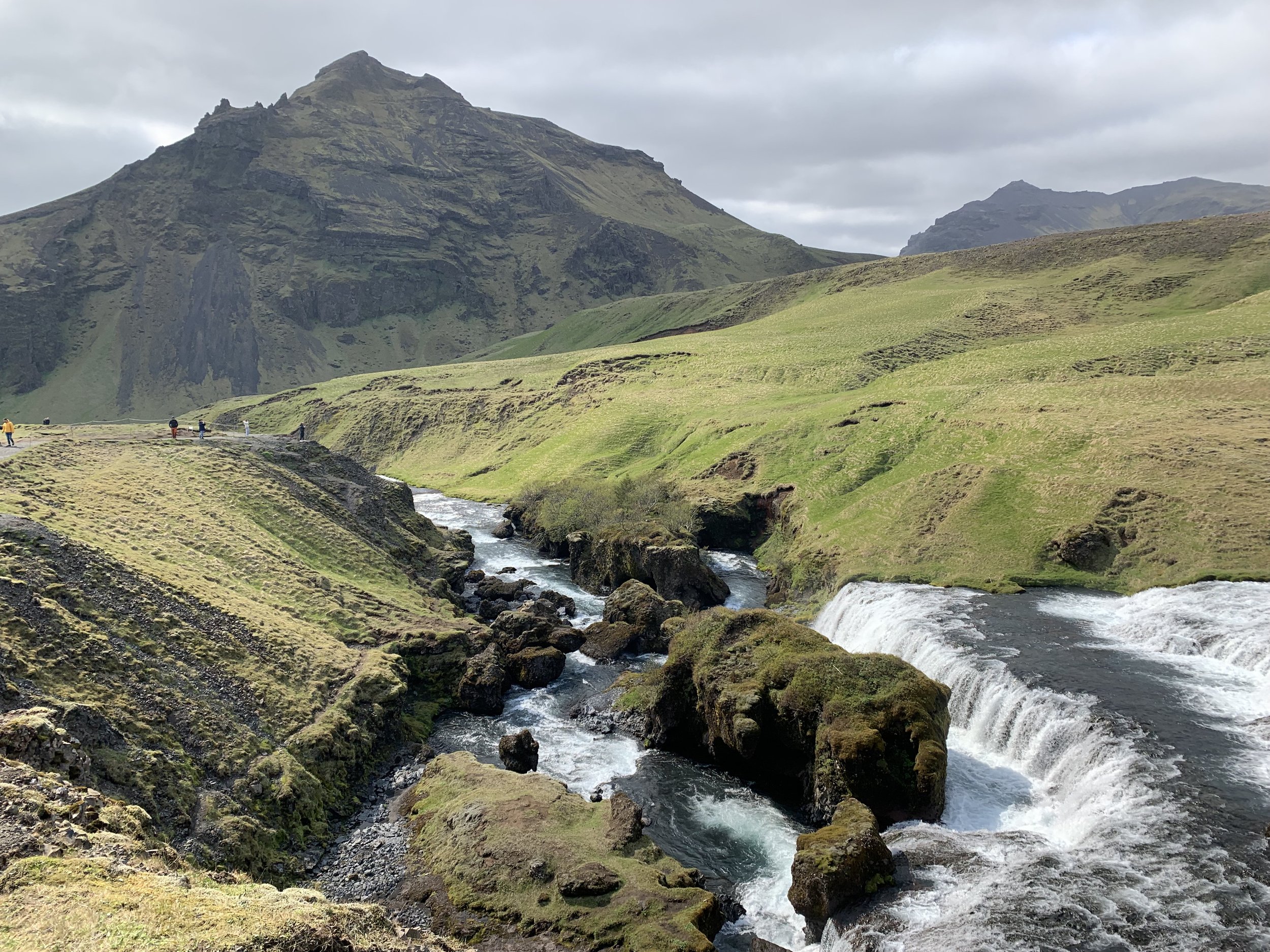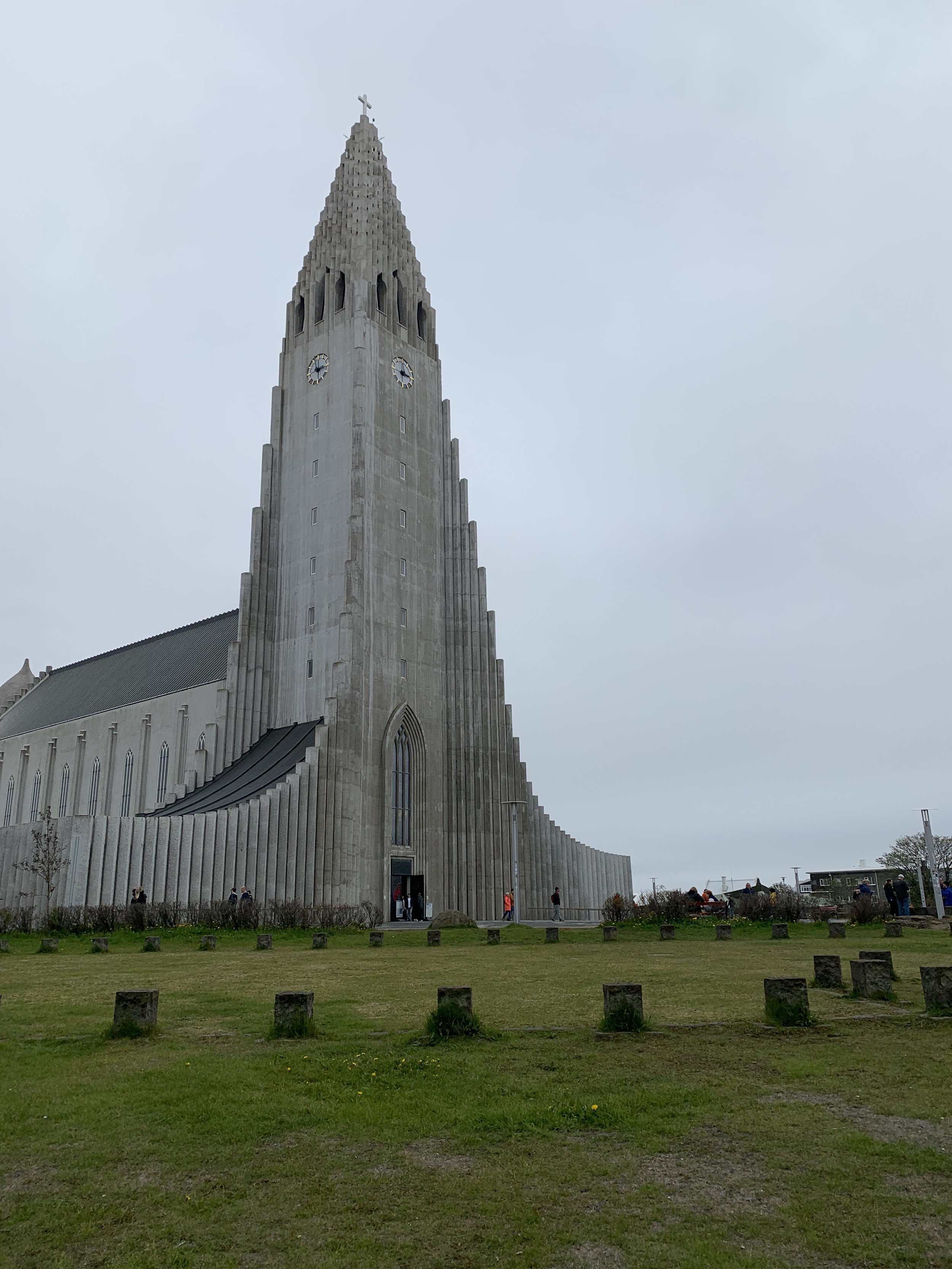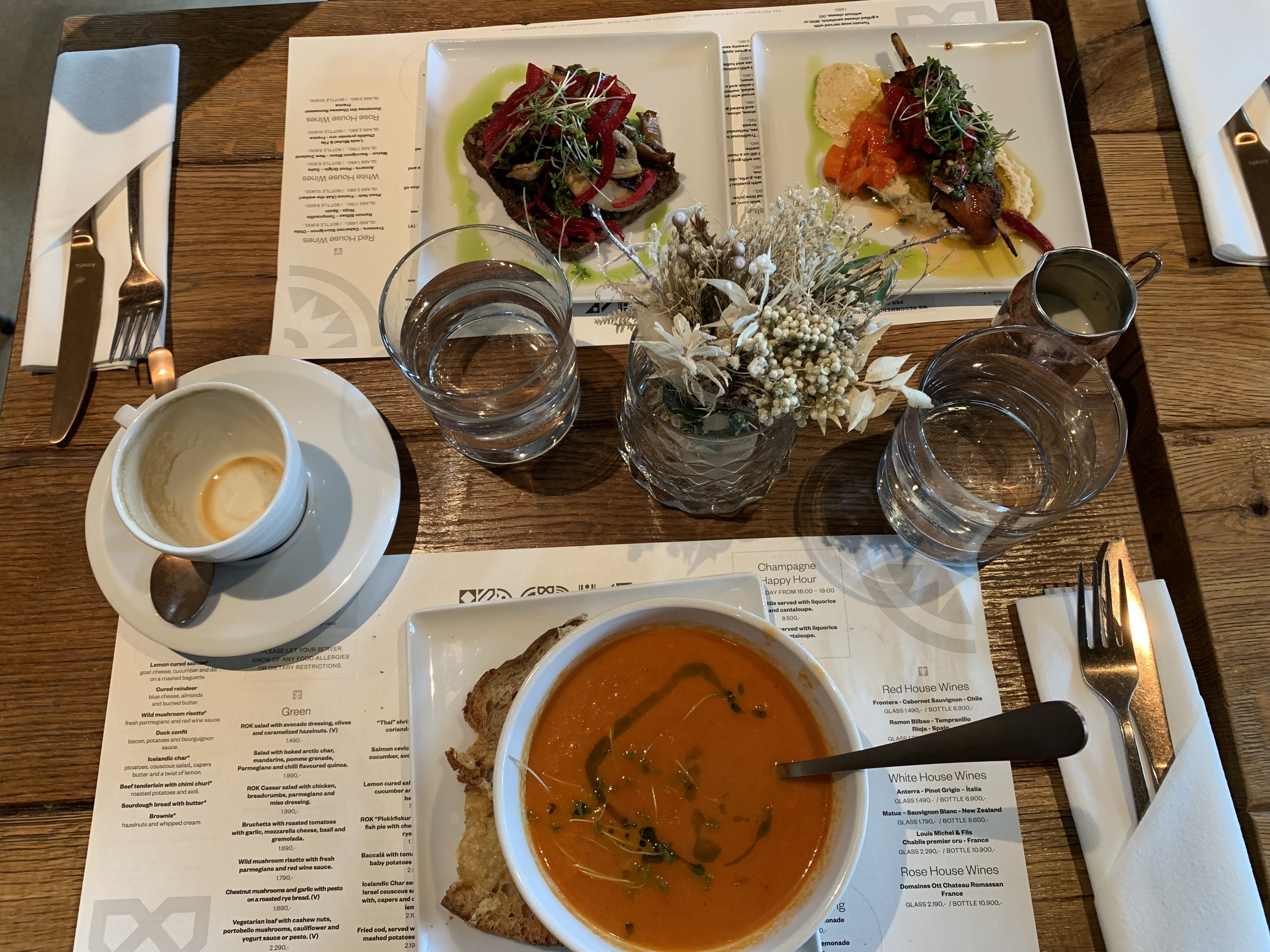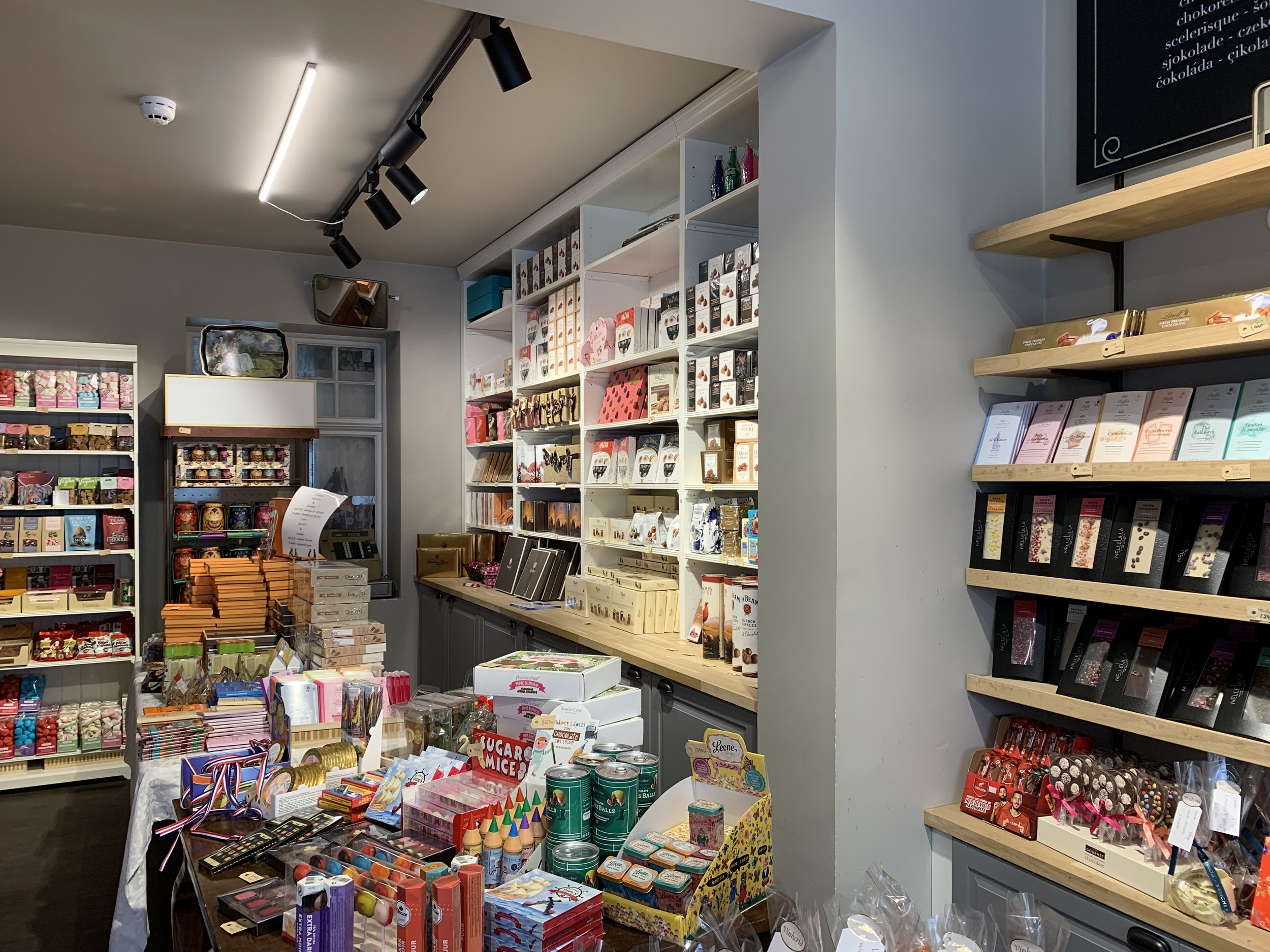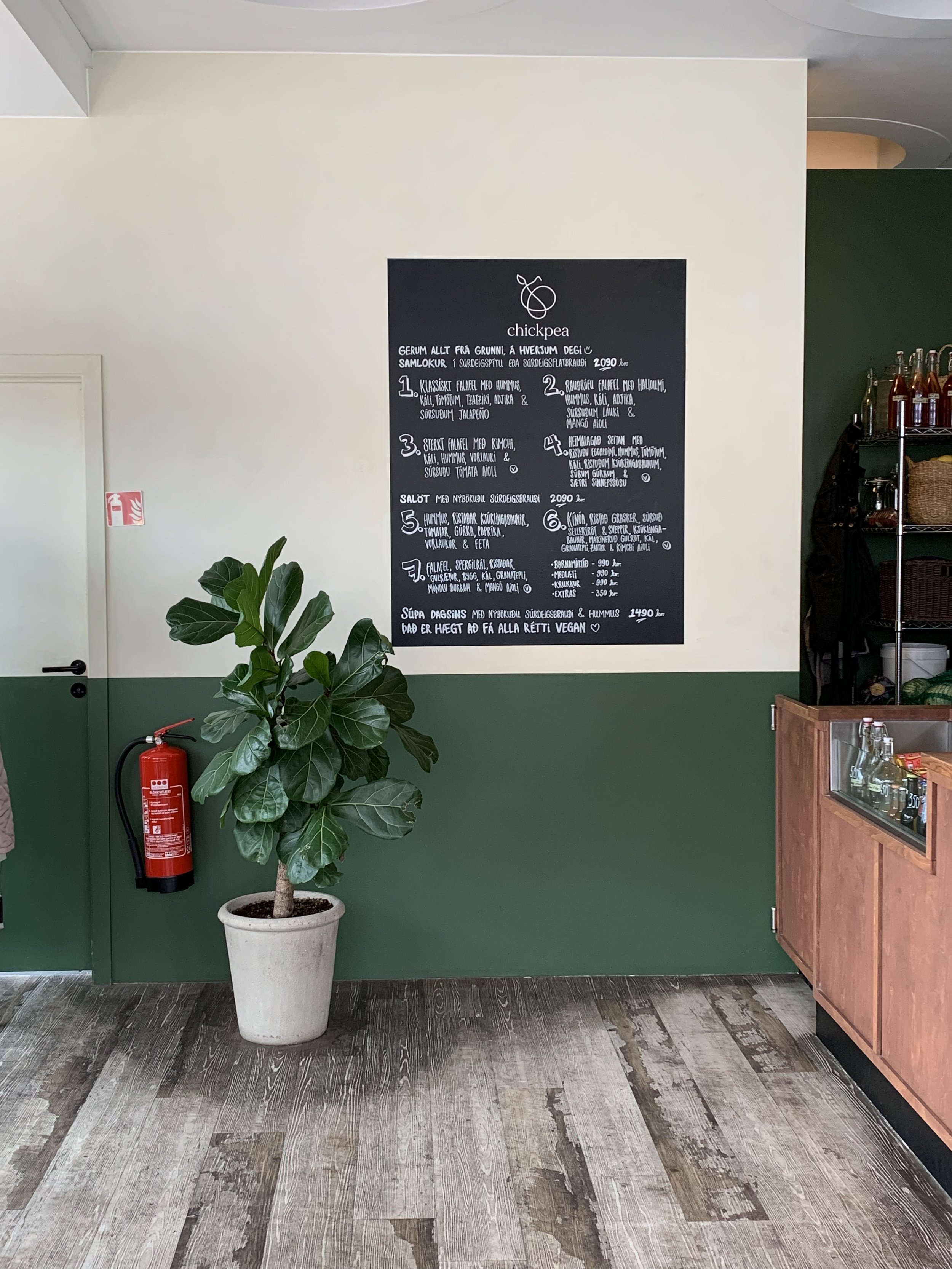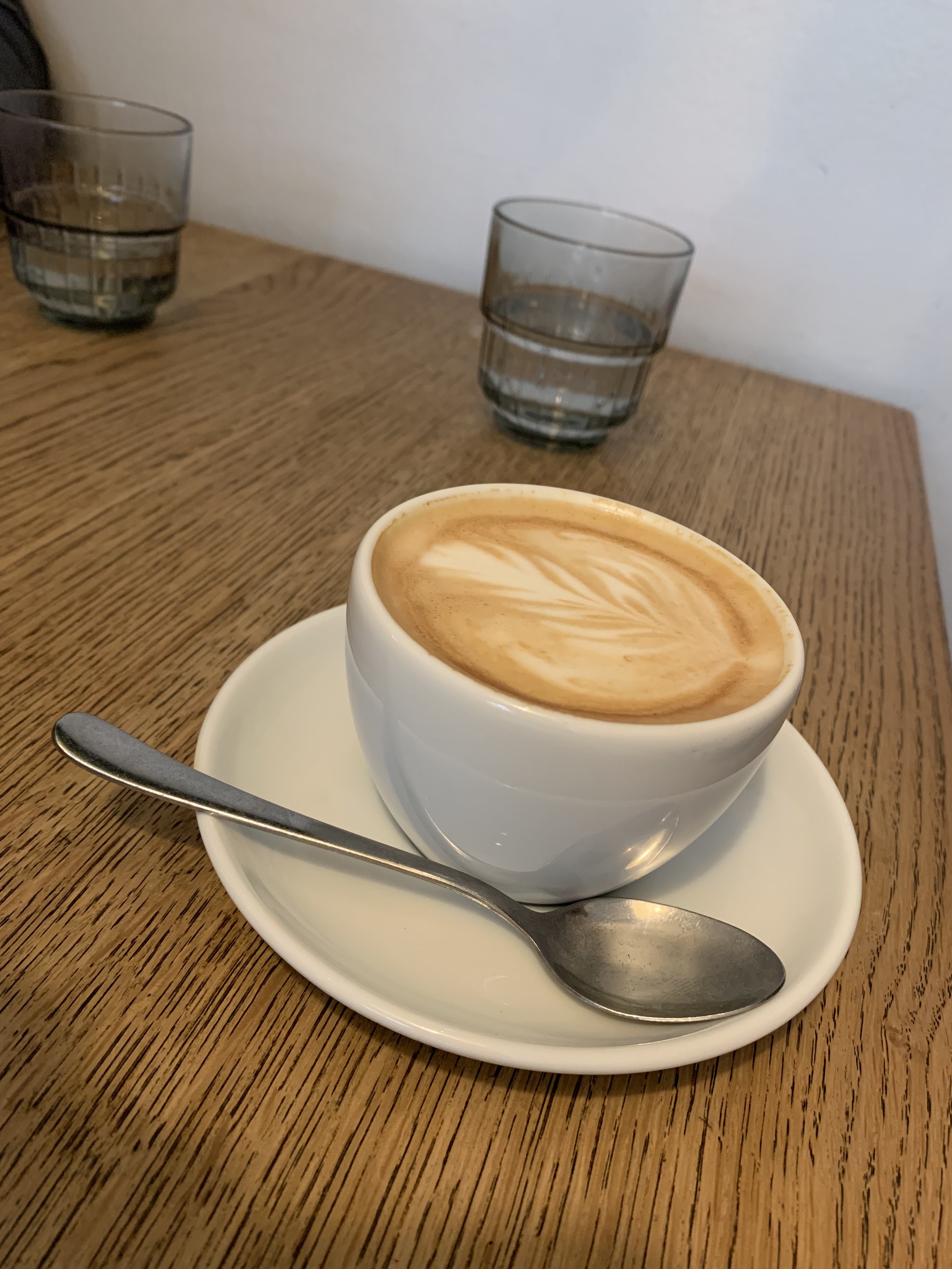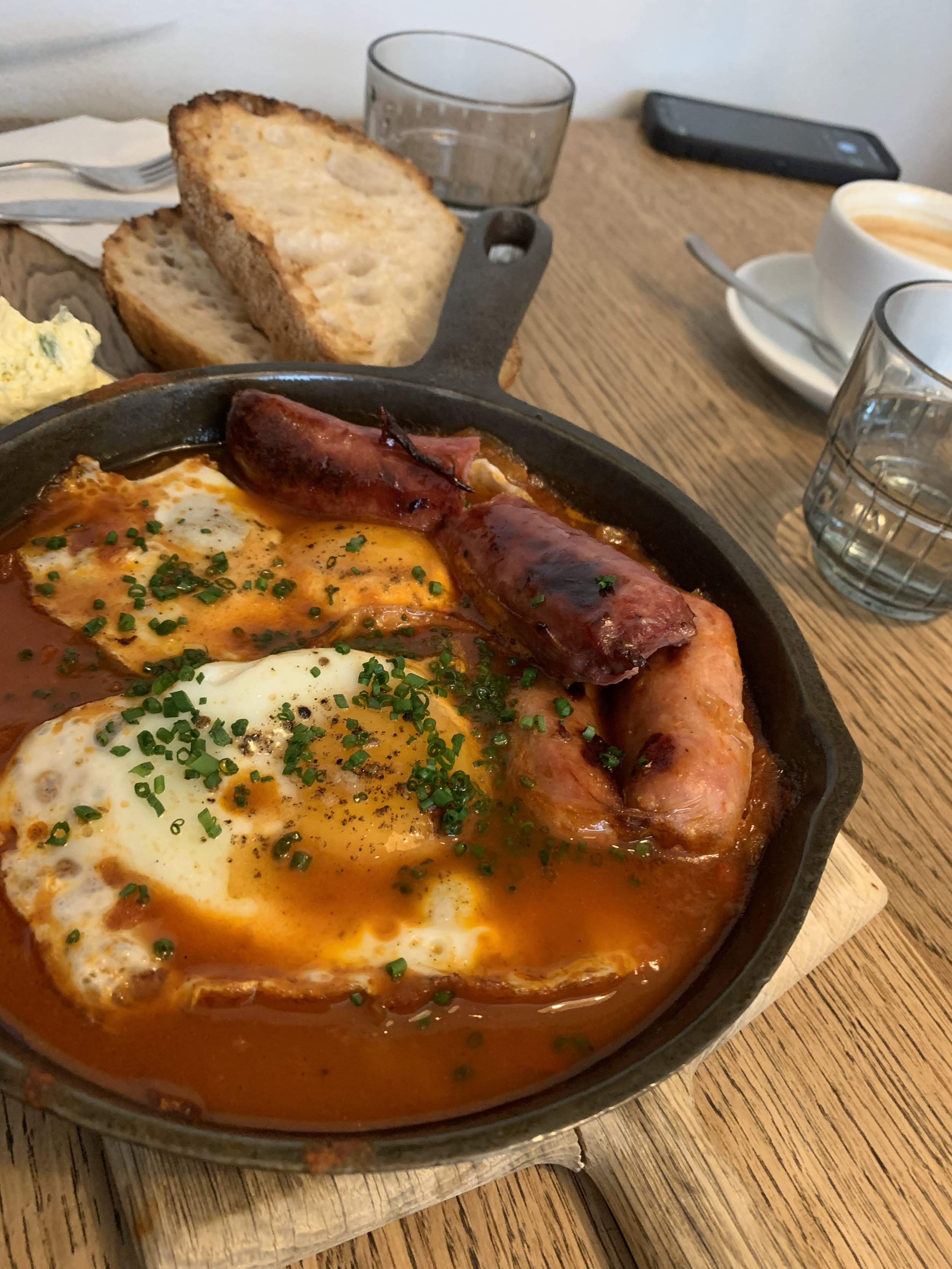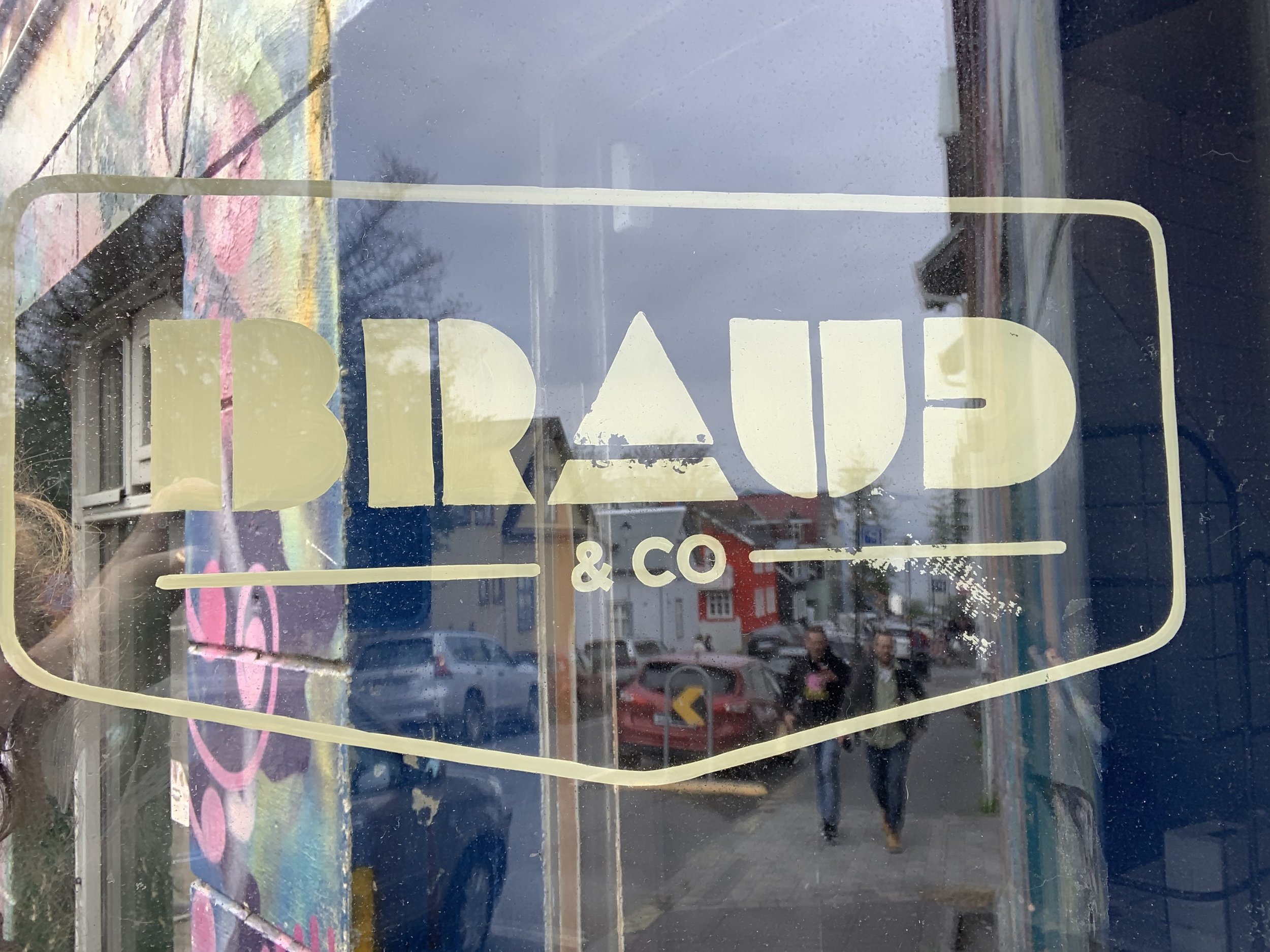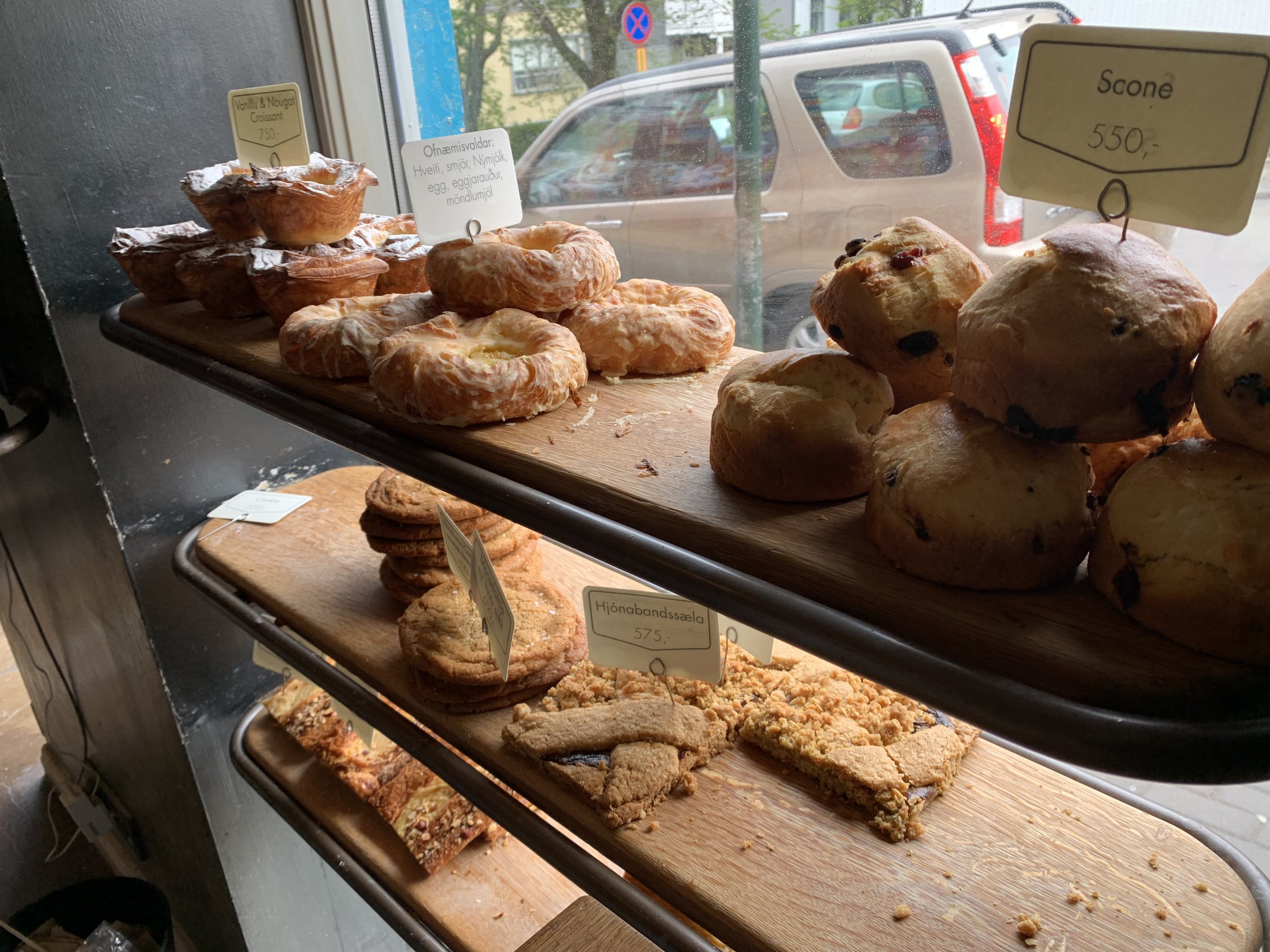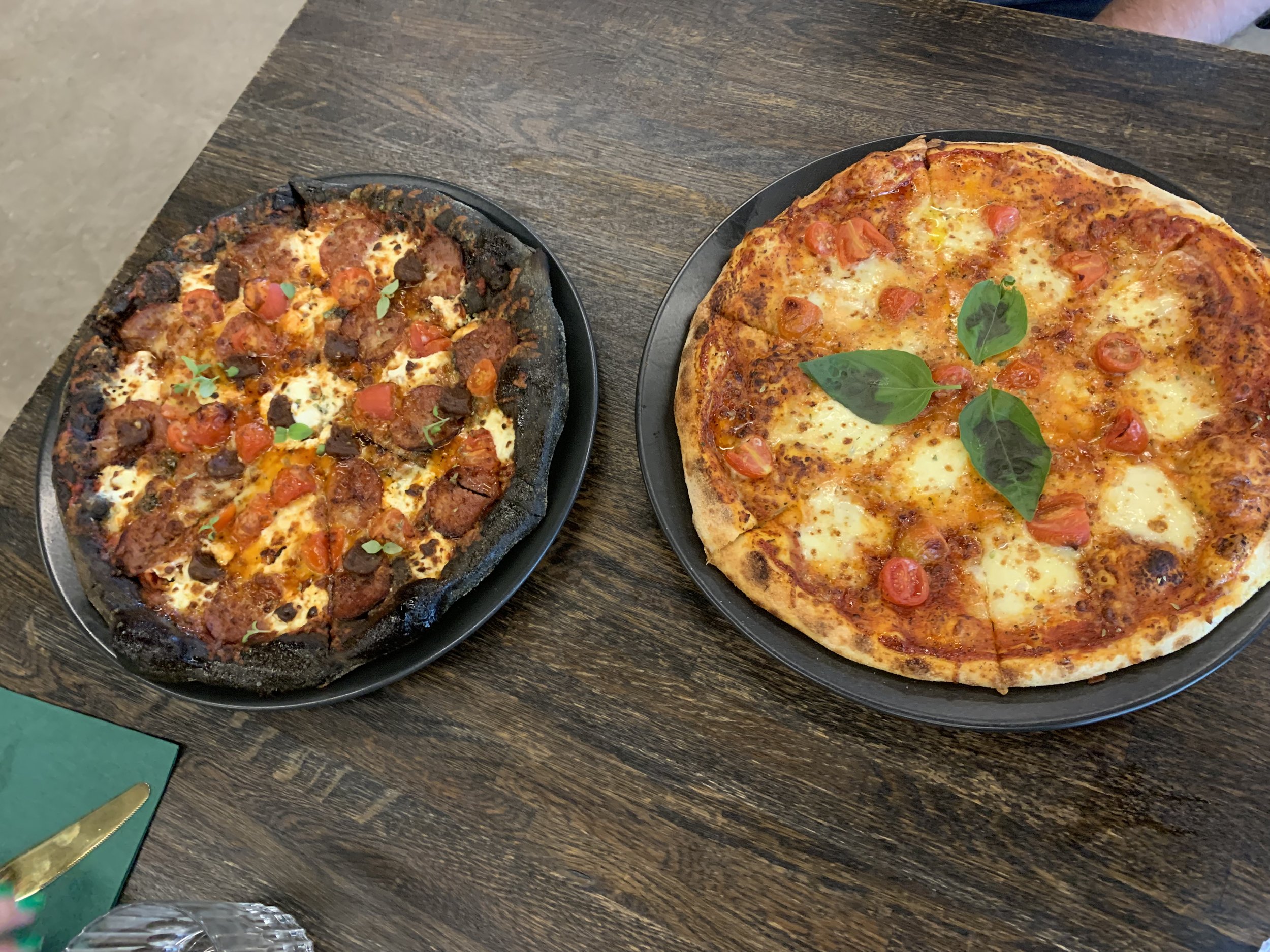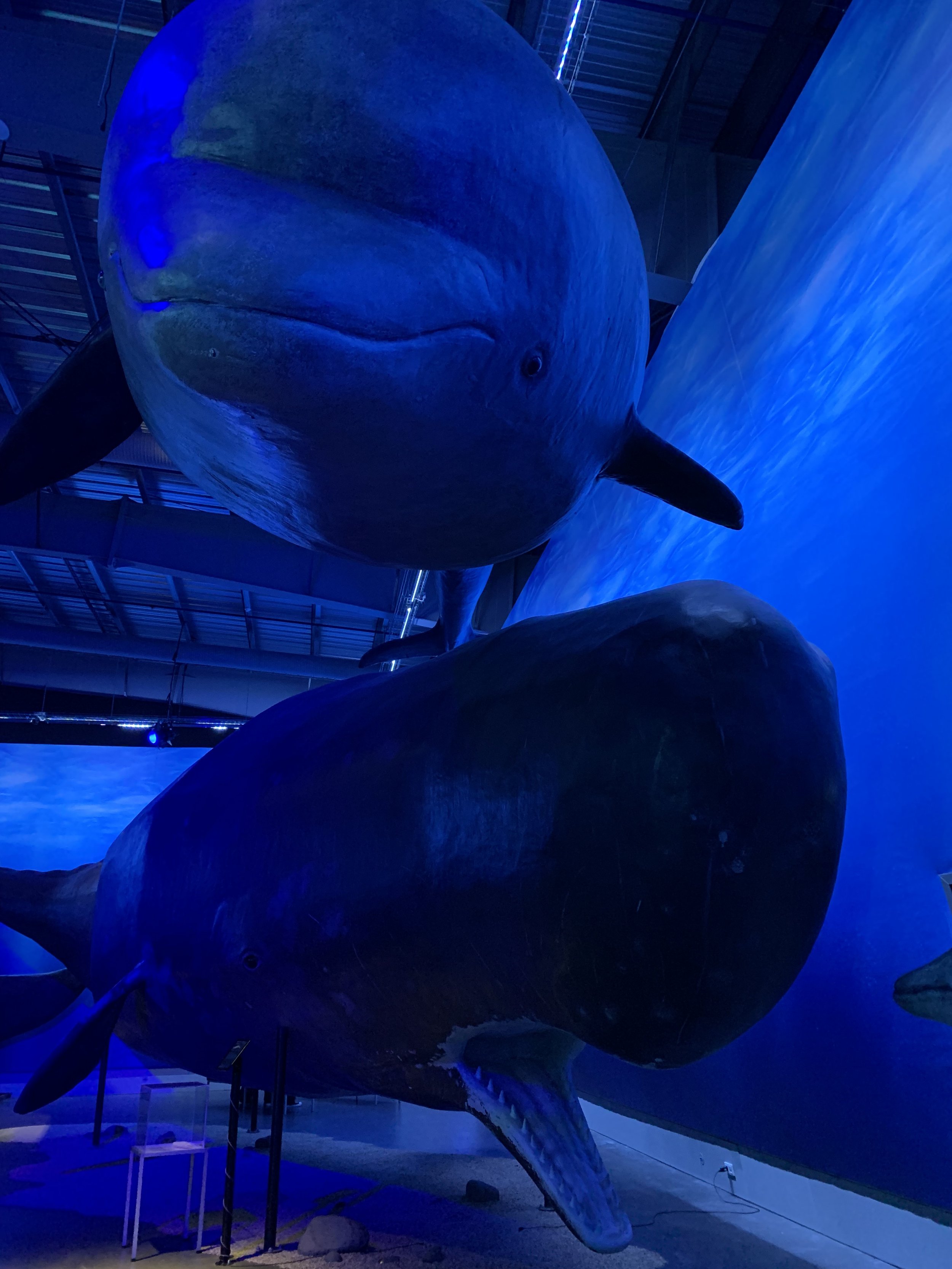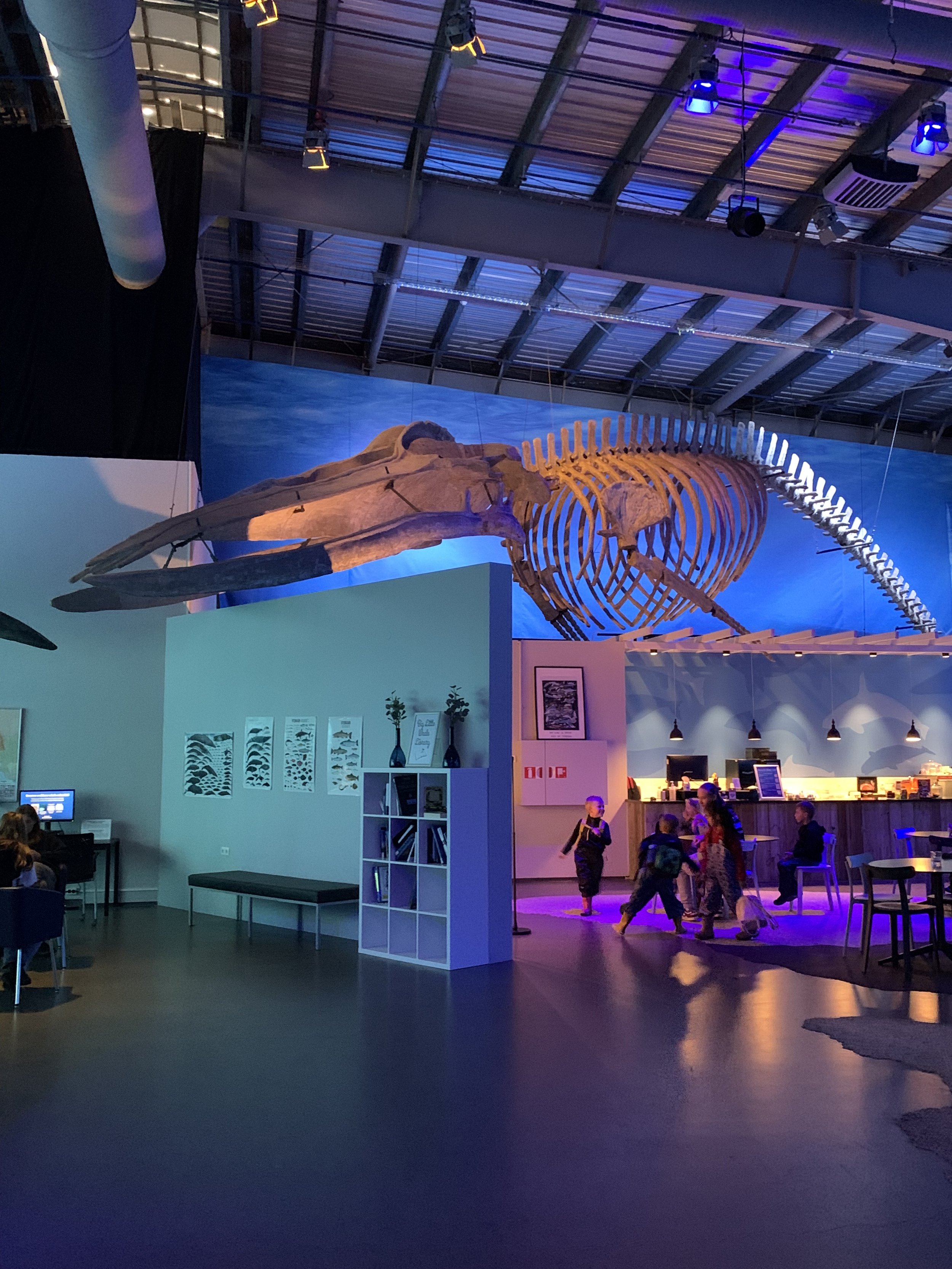Iceland
Good to Know:
Everyone is super nice and majority of residents know English.
Renting a car is the way to go. They drive on the same side of the road as in the United States.
In the summer months it is light out 18-23 hours of the day. Also, there is a significantly lesser chance of seeing the Northern Lights during this time of the year.
1 dollar US is about 140 ISK (Icelandic currency) – in 2023
Iceland uses European electrical adapters.
The tap water smells like sulfur or rotten eggs because the water is heated by geothermal energy.
Lava salt tastes like regular salt.
Airbnb/ Hotel:
Reykjavic Airbnb- We stayed at our Airbnb in Reykjavik twice actually; we started and ended our trip at this cozy two-story town house. It was a great location, being just a block or so away from Laugavegur pedestrian street. The space has two bedrooms, two bathrooms, a living room, and full kitchen with dining table. The decor was modern and cozy. The host kept the facilities extremely clean and all supplies were fully stocked. Parking is available at the lot in front of the townhouse for a price, or at the church for free.
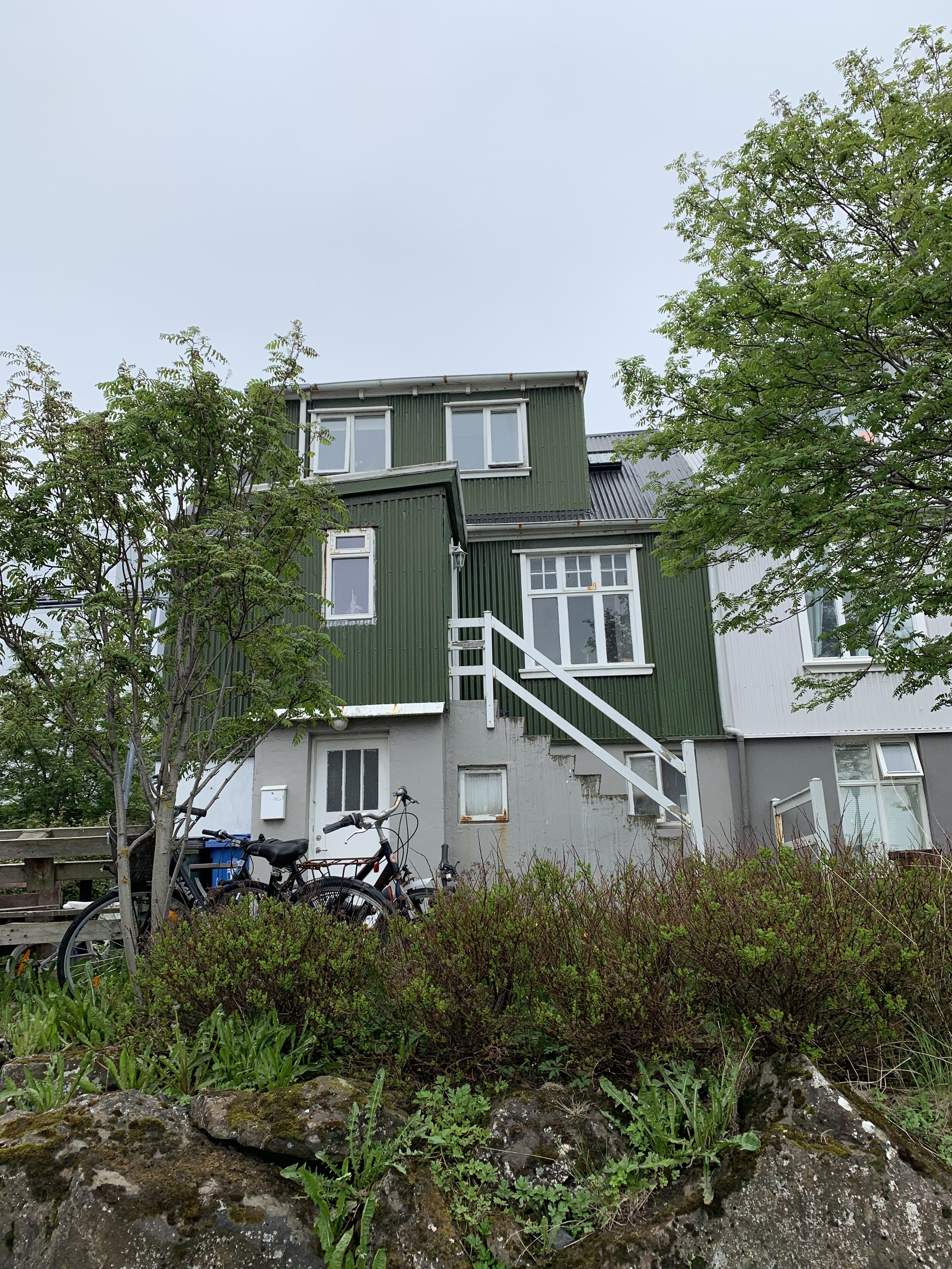
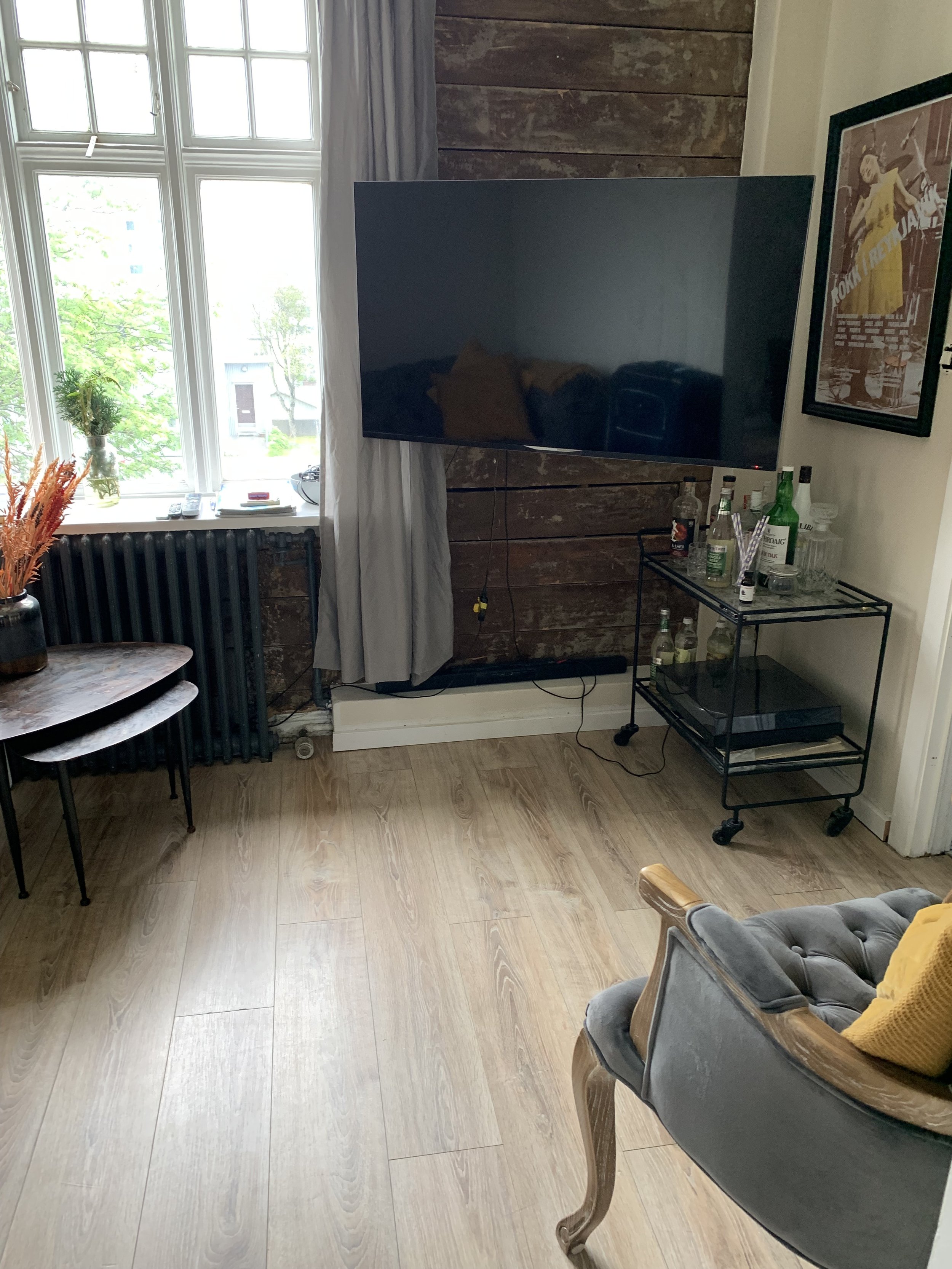
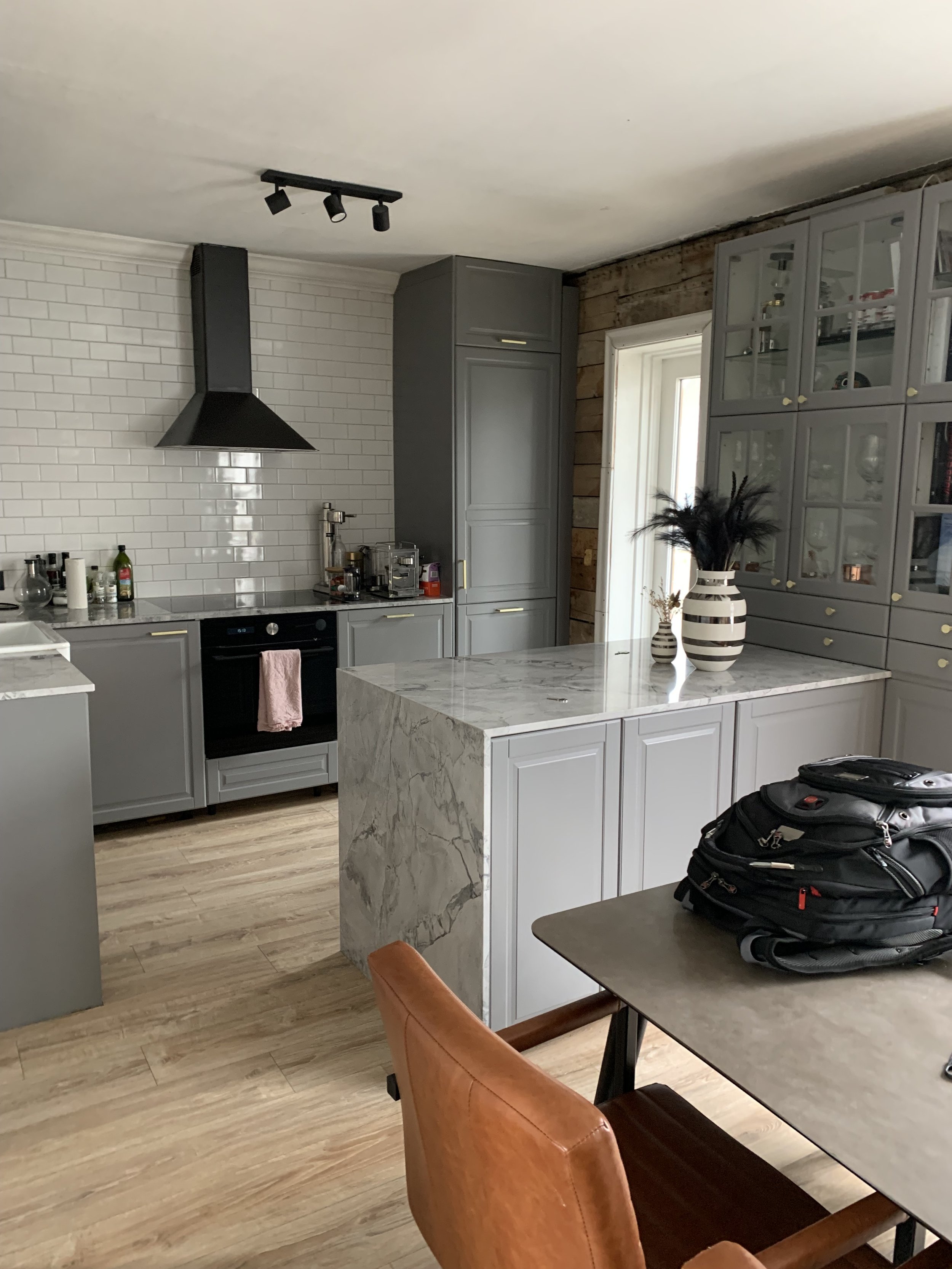
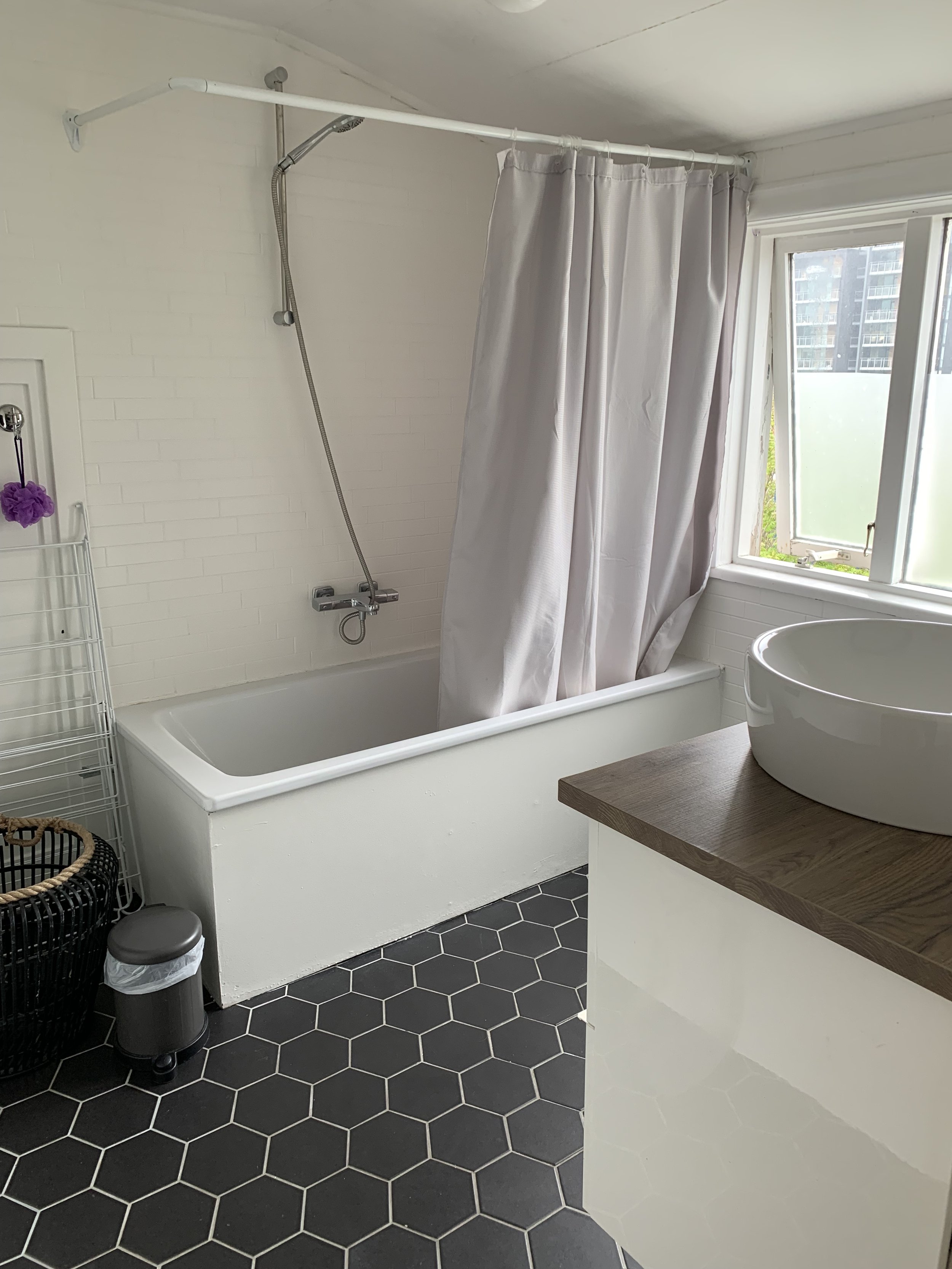
2. Black Beach Suites- I was pleasantly surprised at our accommodations in Vik. The back of our suite was all window, which allotted for plenty of sunlight and wonderful views of the field behind. There were lots of birds singing at all times and a never-ending supply of fresh Icelandic air. The space was structured like a studio apartment, with everything in one open space. There were two beds side-by-side, a small kitchenette, table, and pull-out couch. The only separation was for the bathroom at the front of the suite. The suites are separate from the actual hotel, and each have their own space for parking. The hotel also offers rooms in their main building, as well as dinner and drinks at their bar. Location was great, and only a seven-minute drive to the main hub of Vik; the meeting point for many of the tours.
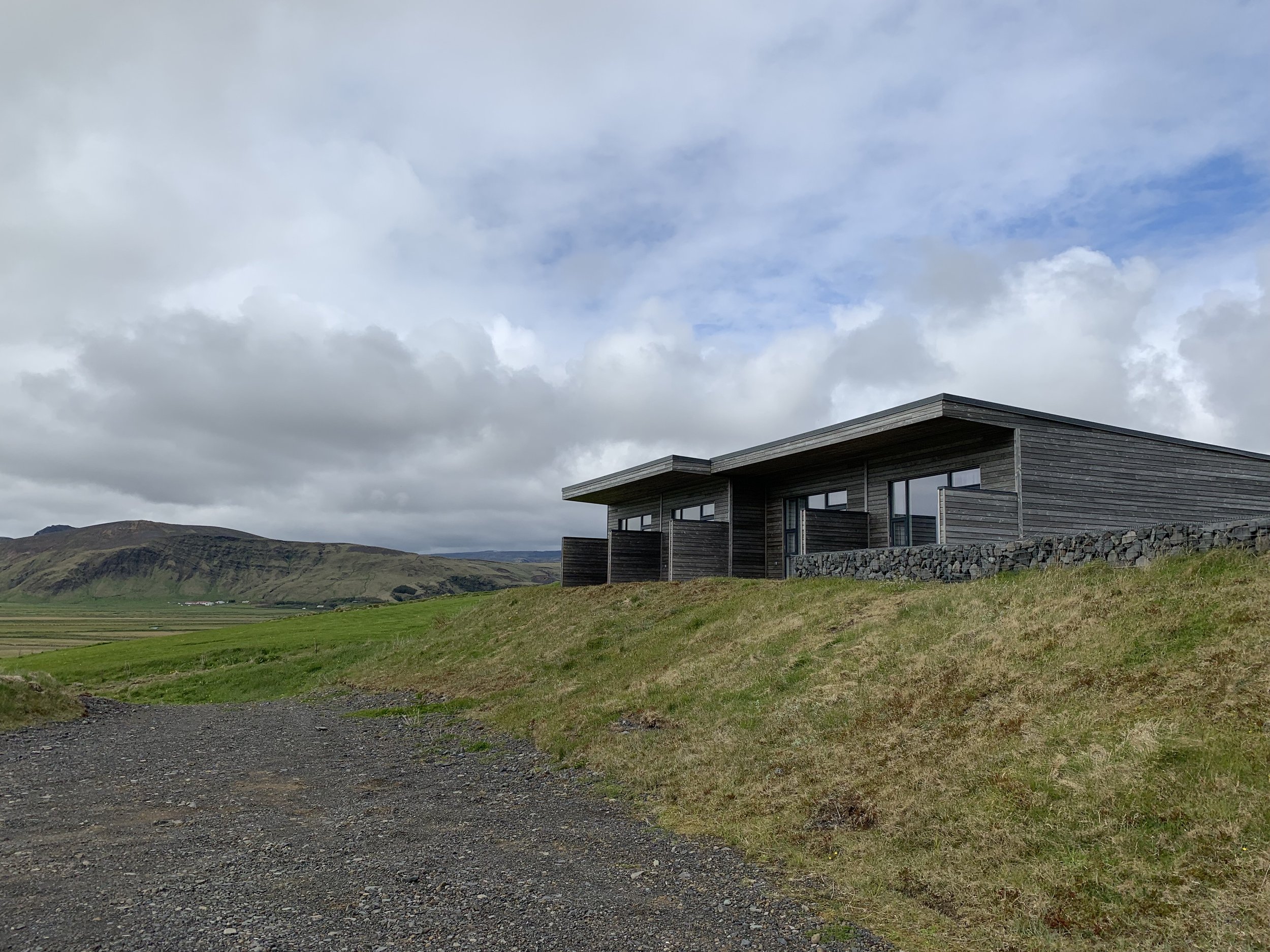
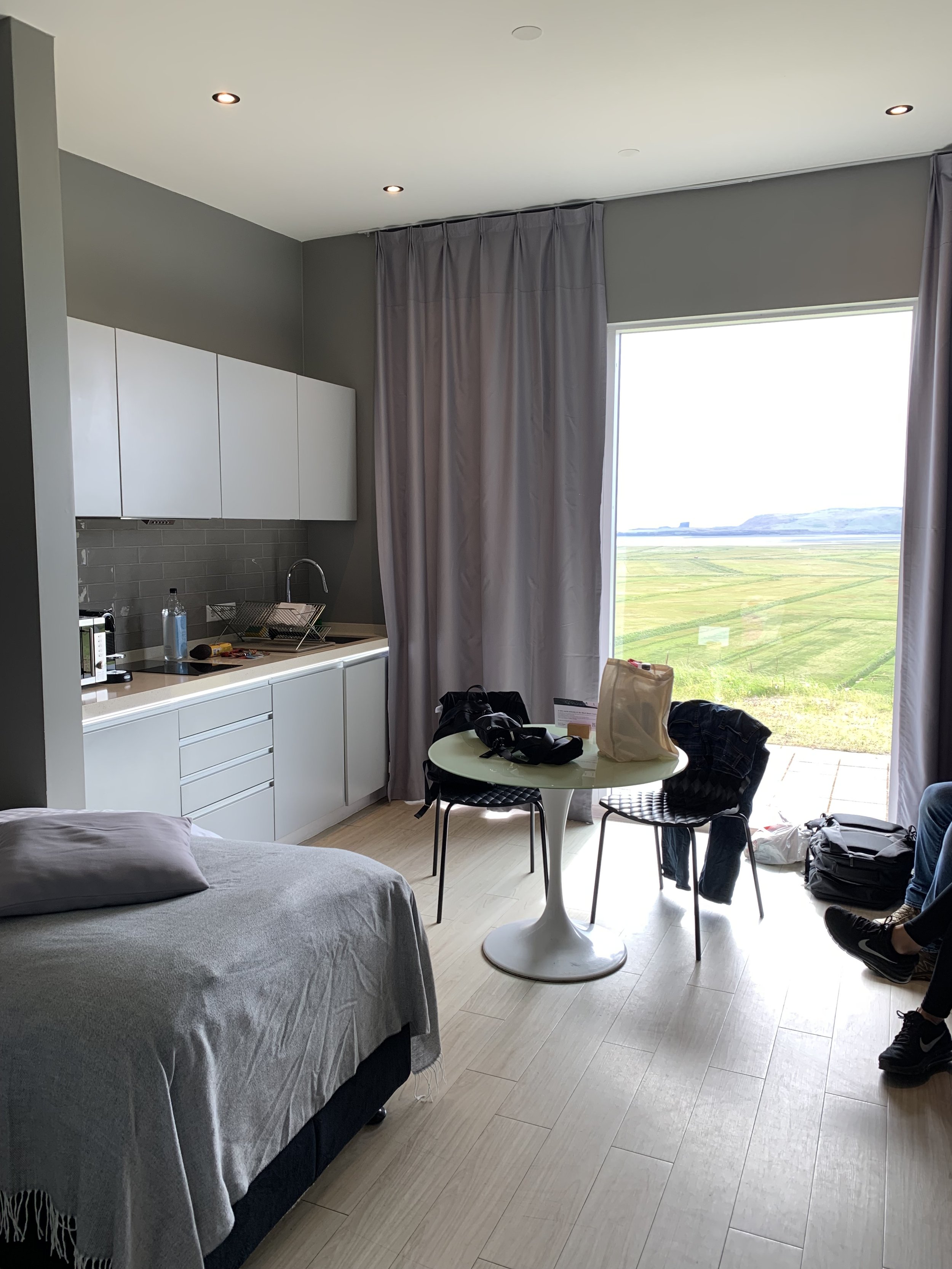
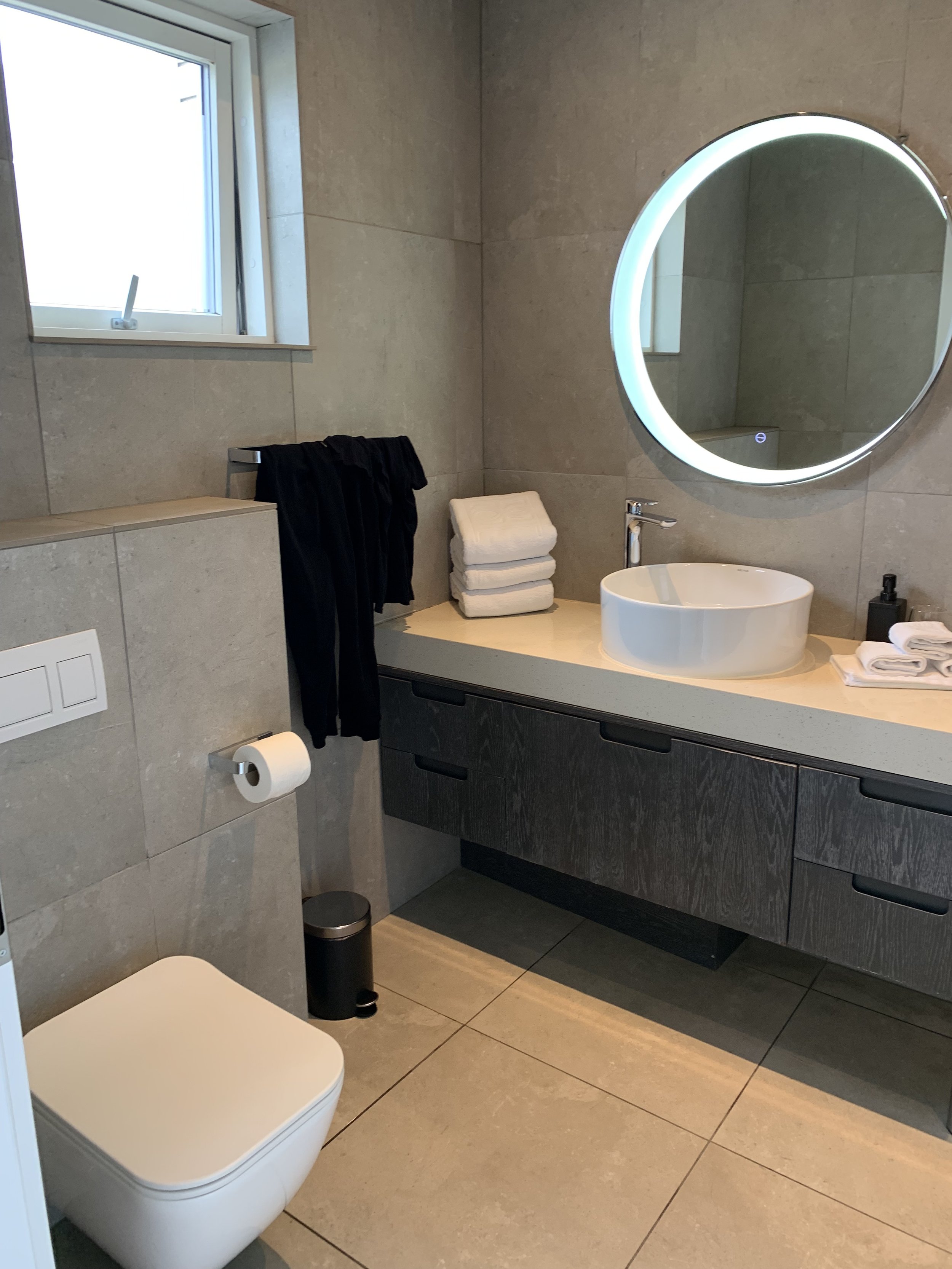
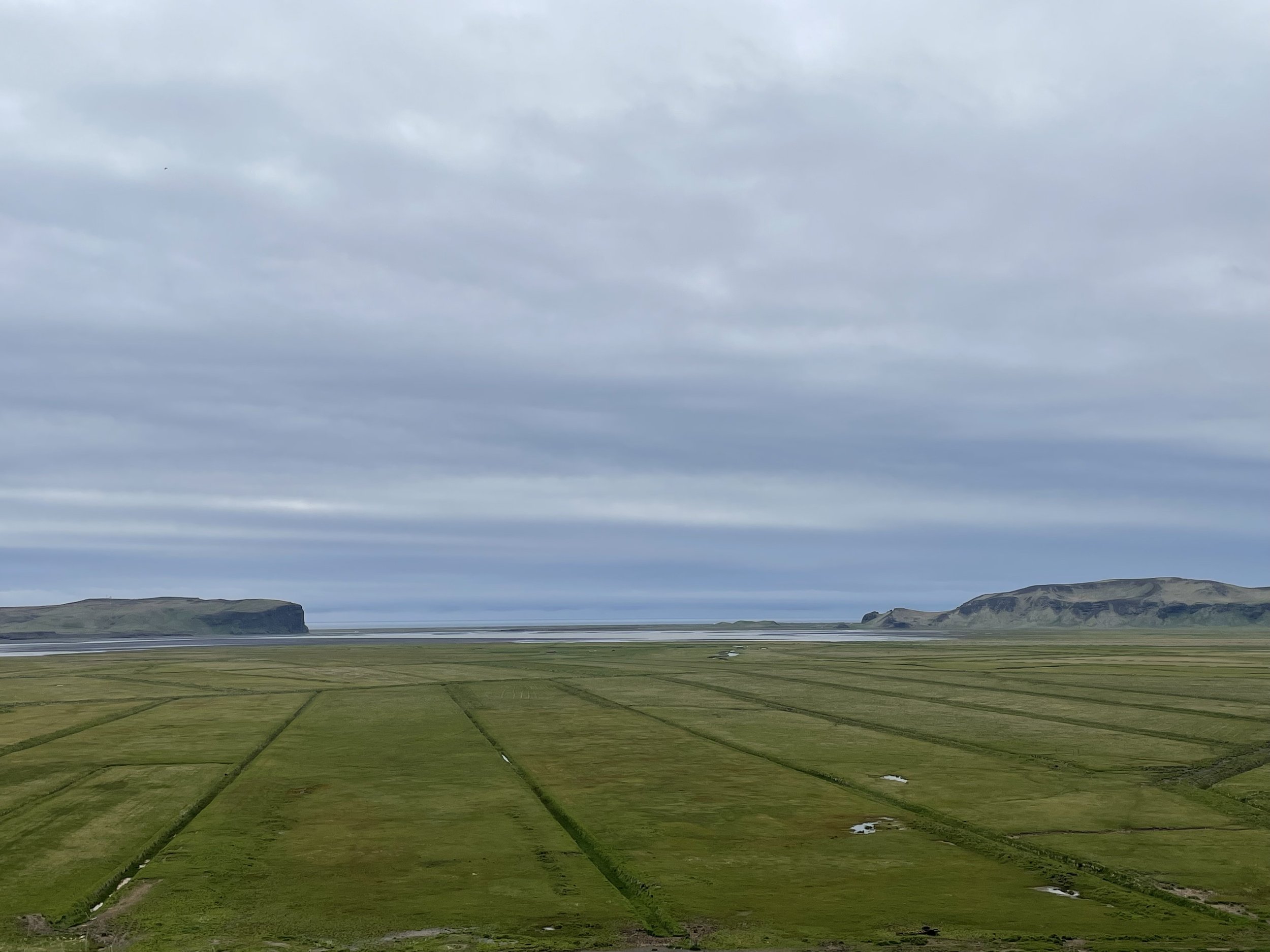
Cities Visited:
Reykjavik- This is the second largest city in Iceland. It has the feel of a small town, with charming shops and restaurants lining the streets. The houses are brightly colored and mostly made of tin, giving a warm contrast to the frequently gray skies.
- Laugavegur is the main pedestrian-only street in the older part of the down town area. There are tons of souvenir shops and a variety of cuisine to indulge in.
- Hallgrímskirkja Lutheran Church is a popular landmark in Reykjavik. It is the tallest church in the country and the distinct architecture was inspired by basalt column rock formations. Entrance into the church is free, but there is a lift to the top for a small price if you desire to see the city from a different viewpoint.
2. Vik- In the actual city of Vik, we didn’t find a lot to do as far as walking the downtown area. It is a lot smaller compared to Reykjavik; more rural as well. There was plenty to do and see during the drive between the two cities though, and the black sand beaches and tours in Vik are definitely worth a trip.
- One place that we admired from a distance but didn’t make the actual drive up the hill to is Reyniskirkja Church. The backdrop for this charming church is absolutely stunning, and it’s a popular tourist stop.
Food:
Reykjavik:
1. Bonus and Kronan are the two main grocery markets we came across in Reykjavik and Vik. They were great for stocking up on water bottles and snacks, for the amount of hiking we did on our trip. The prices were reasonable as well.
2. Rok is a cozy place to rest and replenish for an afternoon of perusing the streets of Reykjavik. They offer a lunchtime deal of 2 small plates for $25 US dollars. They have a variety of fresh and hearty options to choose from. I ordered a delicious bowl of tomato soup that was seasoned perfectly. My brother ordered the chicken skewer and beef taco, and my sister chose the vegetarian loaf and Icelandic cheese plate. Every dish was exquisite and each component was well thought out.
3. Hlemmur Food Hall is a great option if you are traveling in a group or happen to have a few indecisive eaters with you on your trip. It’s a modern and high-class version of a food court with several different restaurants under the same roof. There are restaurants serving pizza, tacos, fish and chips, gelato, pho, and much more. We ate here on two separate occasions; the first time we each chose a bánh mì sandwich from Bánh mì. On the second occasion, we ordered from two separate places. We decided to try the Arctic char as well as fish and chips. I highly recommend the char! It is a more subtle fish resembling Salmon and very popular in Iceland. It is commonly paired with a lemon and caper sauce that helps it melt in your mouth.
4. If you are a chocolate connoisseur like myself, then you must make a stop at Vínberið. It is a candy shop offering chocolate of every shape and form. They have sections for Icelandic brand chocolate, chocolate bars from around the world, and their own truffle case filled with an assortment. I learned that black licorice is a common Icelandic flavor and is often paired with chocolate as well. The staff is very knowledgeable and were really helpful when it came to comparing their candy bars to the Snickers and Twix we’re accustomed to in the US.
5. Chickpea- If you are looking for a fresh Mediterranean meal, this is the place to go. Their menu offers a variety of bowls and wraps with vegetarian options.
6. Sandholt- A few of my favorite breakfasts were provided by Sandholt bakery and restaurant. They had the option to dine in or to order from the pastry counter for takeaway. They offer everything from croissants and pre-made sandwiches, to traditional Icelandic doughnuts and cinnamon rolls. They even have a case with unique chocolate truffles.
Our last morning in Iceland we chose to dine in; we were not disappointed. My brother ordered a hearty breakfast with tomato stew, pork and beef sausage, and bread. My sister and I opted for the sourdough toast with ricotta, mushrooms, mixed greens, and balsamic glaze. Every item was freshly prepared and perfect fuel.
7. Braud & Co. The first bakery we came across upon arrival in Reykjavik was Braud & Co. Not only did the brightly colored spray-painted building catch our eyes, the smells were mouth-watering. The combination of warm cinnamon and sugar delicacies in the window and on the cooling racks, delighted my sweet tooth. An employee recommended the cinnamon roll. I’ve never eaten something so delicious and comforting. The filling was nutty and caramel in flavor, while the dough was soft and warm.
I also ordered what is called the “happy marriage”. It is a chewy crumble cake with a cookie texture. There’s a not-too-sweet rhubarb filling latticed between the layers of oatmeal and cardamom dough. It made for a great hiking snack!
Vik:
1. Black Crust Pizzeria- Our first night in Vik, we did some research and read great reviews about this local pizzeria. We ordered our first pizza based on recommendation by the staff; it came with cream cheese, dates, and pepperoni on a black crust. The crust is black because they make it with activated charcoal, which is good for digestion. The margherita was our second choice, and although the crust was delicious and chewy, the middle was a bit undercooked.
2. Wok on Vik – Our second day in Vik we were on the hunt for lunch. We chose this local Thai food spot. Overall, it was just okay. Everything is pre-made and they just heat all of the veggies, noodles and sauce up together. Overall Vik didn’t have a whole lot of dining options so we went to Kronan grocery market and the café quite often.
3. Lava Café- This bakery was always busy with hungry tourists looking for a coffee beverage, breakfast pastry, or lunchtime snack. We tried the carrot cake with pistachio frosting and the combination was unexpectedly wonderful. We also indulged in a decadent, rich slice of chocolate mousse cake. The mousse was perfectly creamy and chocolatey without being overly sweet, and the brownie crumble on top gave the perfect textured bite.
Tours:
1. Laugarvatn Fontana- If you are a lover of food and science, I recommend scheduling a 30-minute geothermal bread tour. Iceland uses many of the natural resources available to provide more efficient energy to the country. One resource they use comes from the volcanic fissures that run underneath the land. They use the boiling water and heat for baking their delicious geothermal rye bread. The tour takes you out back to a designated patch of dirt where they bury all of their pots of dough. Your guide will show you how they create their craters for the bread to cook, and give you some information on how these fissures and hot springs came to be. After the outside demonstration, you are guided back inside for a tasting. It is recommended to try the bread three different ways. The first is on its own so you can really appreciate the flavors and textures of the bread alone. The second, is to try the bread with a generous amount of butter. (This was my favorite way to eat it.) Lastly, a common way that Icelanders enjoy their bread is with a smear of butter and a slice of smoked trout. I’m not a huge fan of smoked fish, but my brother relayed that this combination was unexpectedly delicious. If you’re driving between Vik and Reykjavik, I would say this tour is worth checking out and only takes thirty minutes.
2. Katla Ice Cave- One of the most impressive tours you could take would be to venture within the Katla Ice Cave. Unfortunately, being that the cave is within a melting glacier, it does change every year. Luckily, there are several ice caves throughout Iceland, and Arctic Adventures offers a variety of tours to explore them.
What is awesome about Artic Adventures and this tour specifically, is that they offer pickup from Reykjavik if you are not staying in Vik. The drive is pretty significant, but you do make a couple stops at various waterfalls along the way.
If you are staying in Vik, then the meeting point is really easy to find and is in the back parking lot of the Lava Café and Kronan market. There, you will meet your guide and hop on a van equipped with some of the largest tires I’ve ever seen.
The drive to the ice cave is only about 45 minutes, and the scenery is amazing. Your first stop is before you make it to the actual glacier. This spot is special, not only for the scenic views of the green mountains and white glacier, but because the opening scene in Rogue One was shot at this location as well.
From here, you have a very short way to the glacier. Upon arrival, you will be supplied with a helmet and crampons to assist with the hike. Before entering the actual ice cave, your guide will give you a bit of history about the evolving glacier, and how volcanologists measure activity in the area.
Upon entering the ice cave, there was a lot of rushing water and white noise, but the views were incredible. The combination of surface textures with the contrasting blues, teals, and grays is amazing. There are wooden bridge crossings and safety ropes set up throughout the tunnel. Staff are constantly working to secure the bridges. The bridges themselves are slightly moss-covered and softer from the constant melting glacier water. They are big enough for one person to cross at a time, which is nice for taking photos. It is very wet in the cave, and the rushing water in the creases below is a reminder of just how much the glacier is melting. Looking up, there are several arches overhead that are the made of the most beautiful waves of ice.
Once through the cave, you will come out on the other side into this crater-like oasis of gray mountains. Exploring this area was probably the most difficult since the rocky ground was softer and at times would give out under the crampons.
There was a waterfall at the head of the crater, where we all made our way to and back from. The sound of rushing water and the gray hues of the mountain peaks around us really did feel like we were on another planet.
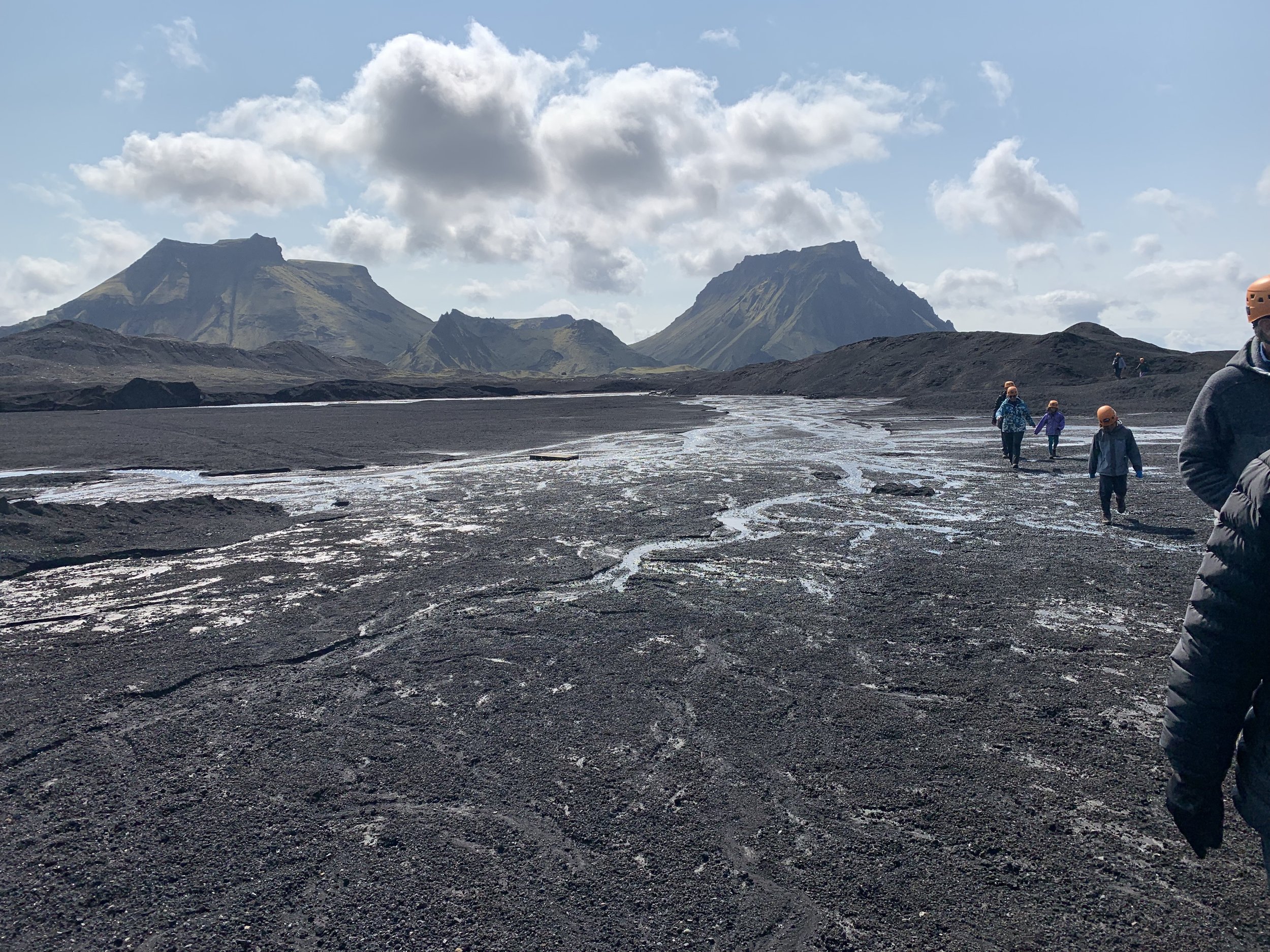
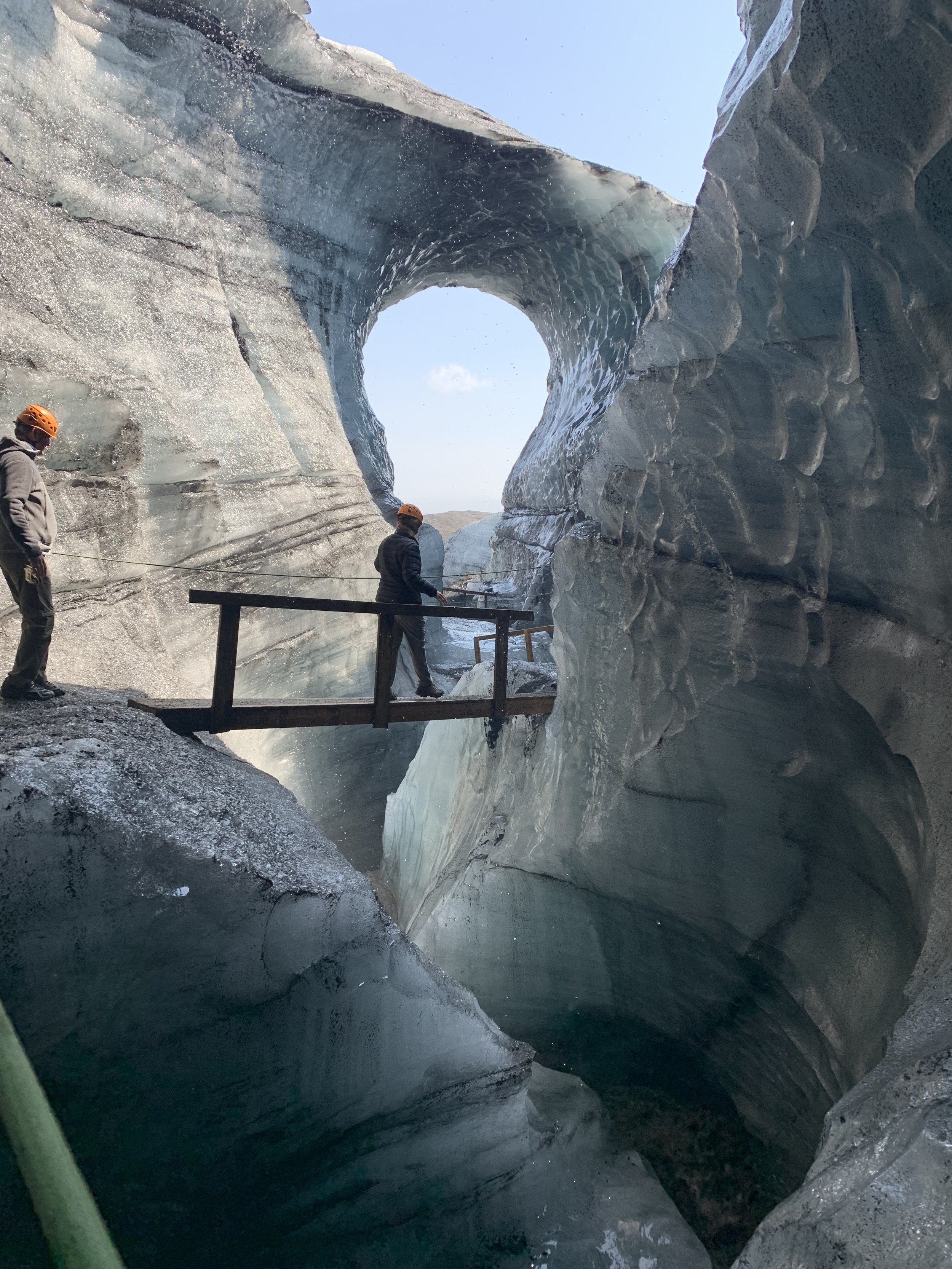
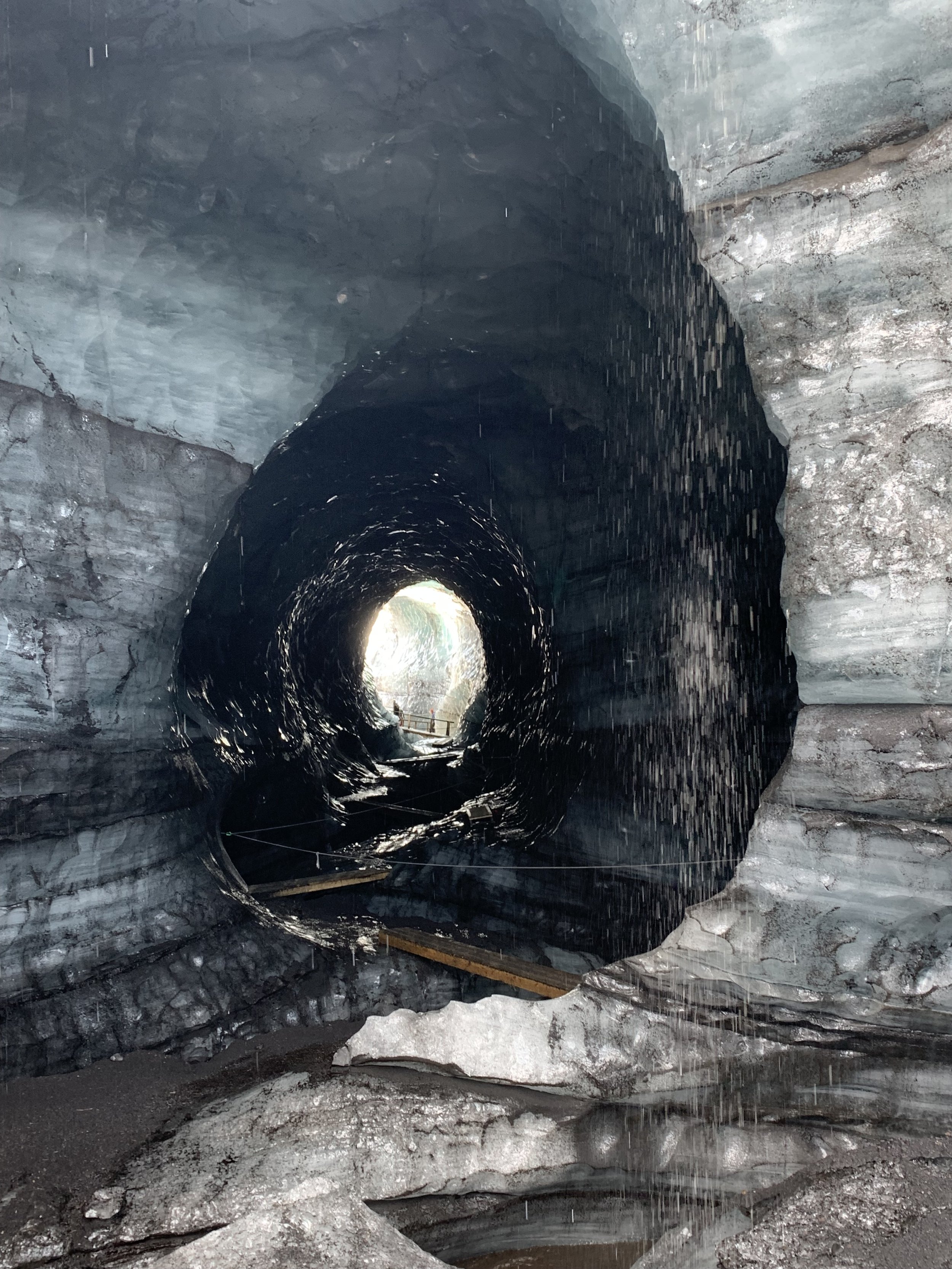
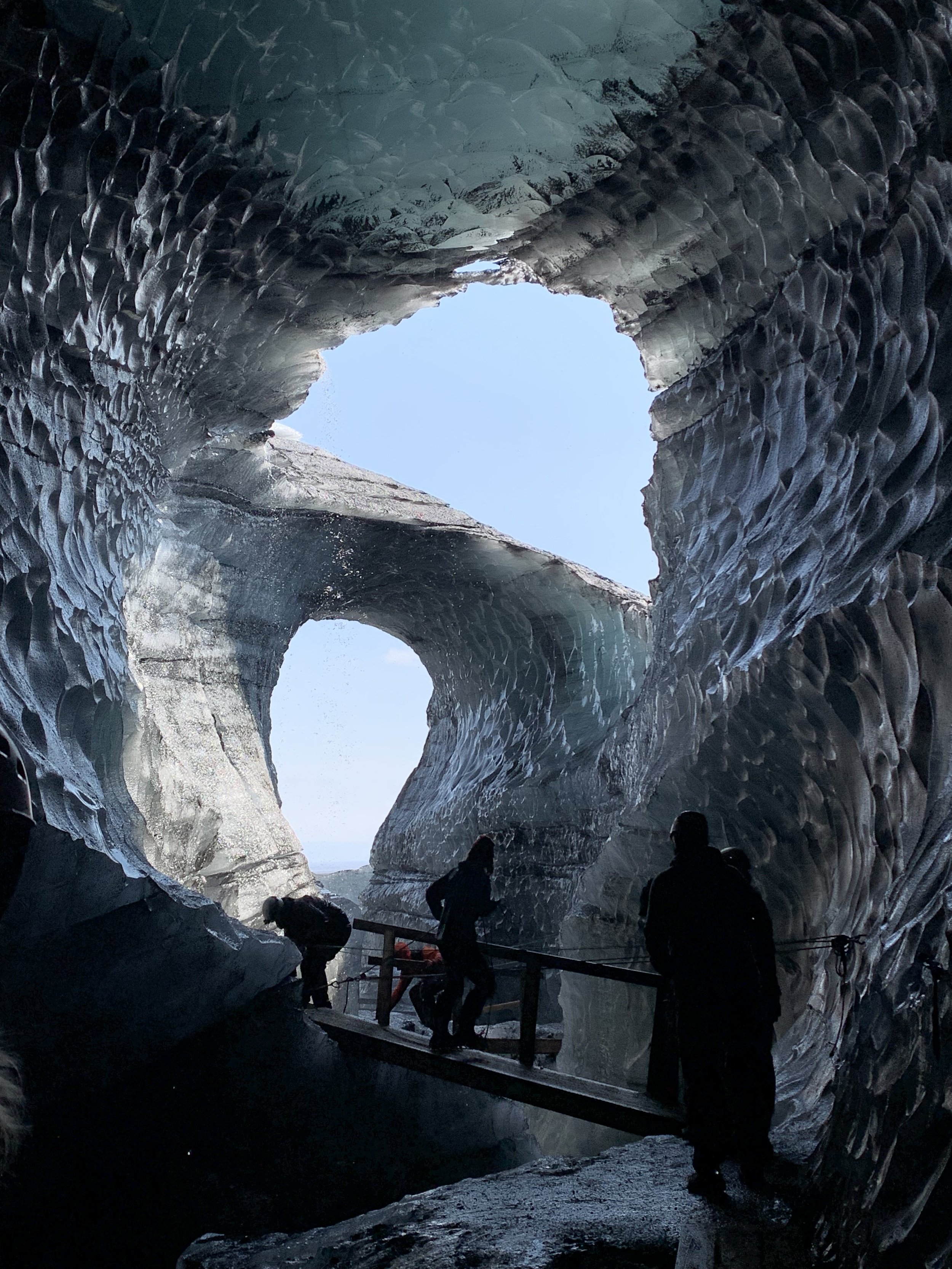
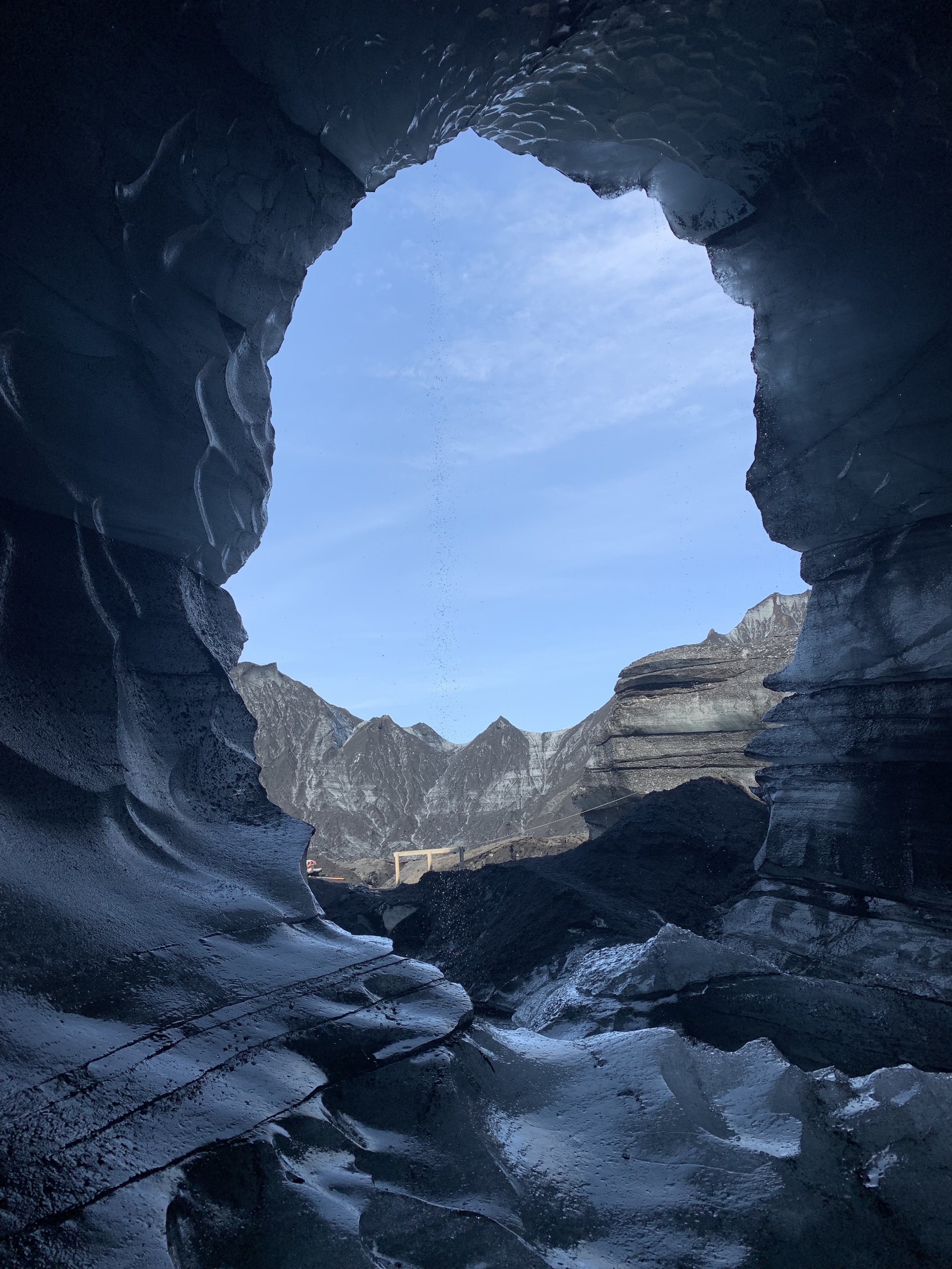

3. Inside the Volcano - Thrihnukagigur Volcano in Iceland is the only one in the world where you can enter and explore the magma chamber of a dormant volcano. It is a must-see on your trip! The volcano is just outside of Reykjavik and shuttles are provided to take you to and from the site. The entire experience takes around 5-6 hours including the drive and the 2 mile walk to and from the actual crater of the volcano.
There are several meeting points in Reykjavik where you will catch a bus that takes you to the shuttle pickup point. From there, it’s about a 45-minute drive to base camp for a quick briefing on what will happen for the rest of the tour. Then, you will set out for the two mile walk towards the volcano.
There is a dirt path to follow, and two guides are with you at all times during the walk. It can get a bit windy at times, so I suggest bringing a scarf and hat if you are going during a time where the temperature only gets up to 50 degrees. There is plenty of time to take photographs along the way, and a few stops where the guide teaches you about the volcano and the development of the crater. At one point you will come to a bridge and a divide in the ground. This is a stretch mark of the Eurasian and North American tectonic plates and where they meet.
As you approach the volcano, your guide will split the group into smaller teams. Each team will take a turn going down into the magma chamber.
At the second base camp you are given a few refreshments like coffee and hot chocolate while a few new guides go over safety. You are equipped with a helmet that has a front light, as well as a harness to clip onto the lift. Total decending time is about 7 minutes into the chamber. The lift works like a pulley system and is equipped with wheels at the corners to gently guide past the rocky walls.
Once the lift has come to a stop, everyone gathers in front of the guide to learn about the inside of the magma chamber and all of the rock colors. The varying colors actually come from different gases. Iron oxide makes red, sulfur makes yellow, silica is white, and copper is green. From top of the volcano to the chamber bottom is about 120 meters, or 400 feet.
You are given about a half hour to explore and take as many pictures and video as you can. There are pathways to follow along the perimeter of the base, with ropes to hold onto since it is very rocky. The entire half hour is breathtaking and magical.
Even though the volcano has been dormant for 4000 years, it’s still an eerie feeling being inside this incredible beast that had erupted at one point. The thirty minutes goes by relatively quick, and before you know it, you’re heading back to the top. There is time to explore the peak as well, and incredible views of the lava field.
The tour provides traditional Icelandic lunch, as well as beverages.
I suggest talking with the guides and learning as much as you can about Iceland and its landscape. Everyone is very knowledgeable and passionate about the outdoors.
Inside the Volcano is literally a once in a lifetime experience you do not want to miss out on!
Other Activities:
Fagradalsfjall is located about an hour south of Reykjavik and is a hiking experience like no other. The volcano has erupted several times since our trip, so I can only imagine the black lava that has layered over what we had seen. It is not advised to touch the lava being that there are still gases below the surface which can be toxic, but you can come pretty close to it and get a lot of great photographs.
There are a couple parking lots to choose from depending on which of the hikes you wish to conquer. We chose Parking Lot 2 since our plan was to make it to the Nátthagi and Stóri Hrútur viewpoints. The Nátthagi viewpoint is where you can get closest to the black lava, while Stóri Hrútur is the highest hiking point on the right side of the crater. The hike here is almost two hours depending on your pace.
The hike to Stóri Hrútur took us a little longer just from the stops to take pictures and video. There is a lot of ups and downs on this pathway and it can get very rocky and slick. When you think you’ve made it at the first hill, you realize there’s a whole other mountain to climb to the end. It can get quite windy and foggy, but the weather is constantly changing. If you think you’ve completely missed an opportunity to see something, give it ten minutes for the fog to clear.
The hike is a physical challenge, but the views with every step are stunning. You are walking side-by-side following the lava flow and as you get higher, are able to see more of the crater as well as the lake behind you. The crater itself is actually quite small. You can only see the very top of it, versus this gigantic and towering mountain you’d expect. There are also salt deposits in the distance that are spatters of lime green in contrast to the dark and cracked lava. If you choose to solely hike this one path, there is a divide between the two hills where you can get very close to the jagged black lava as well. Once you’ve trekked your way to the very top of the mountain, you have awesome panoramic views, not only including the crater, but the surrounding green hills, lava, and ever-changing sky.
Be aware that there is no place to grab refreshments on this hike; make sure to carry a backpack or fanny pack with snacks and water. There are port-a-potties set up at the parking lot if necessary, but that’s about it.
You also are responsible for paying for parking upon entry. There are stations set up where you use your smart phone to scan and pay online.
Lastly, remember to layer up! It’s always better to over-dress than to be unprepared. You want to be able to enjoy the journey and the scenery around.
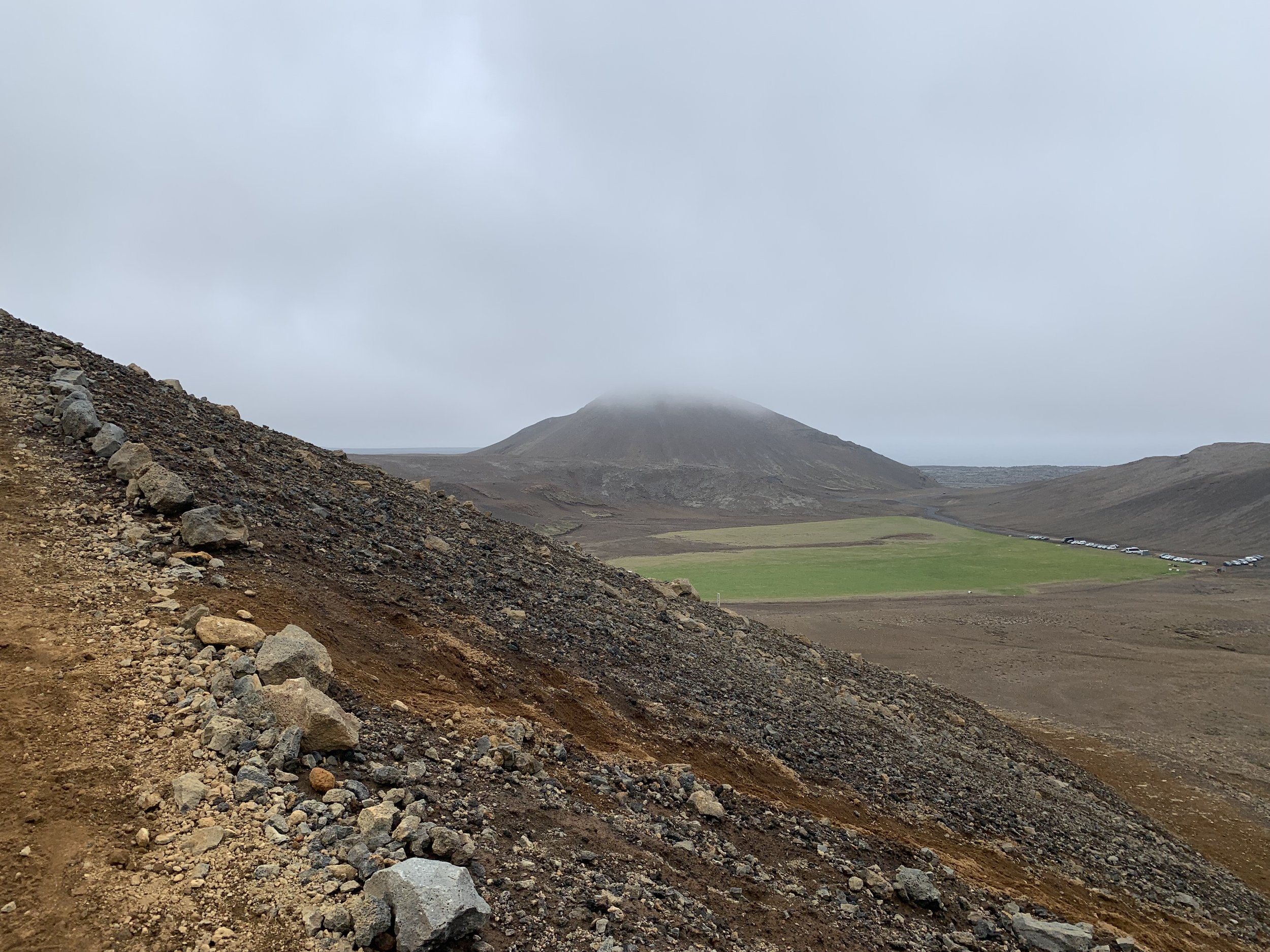

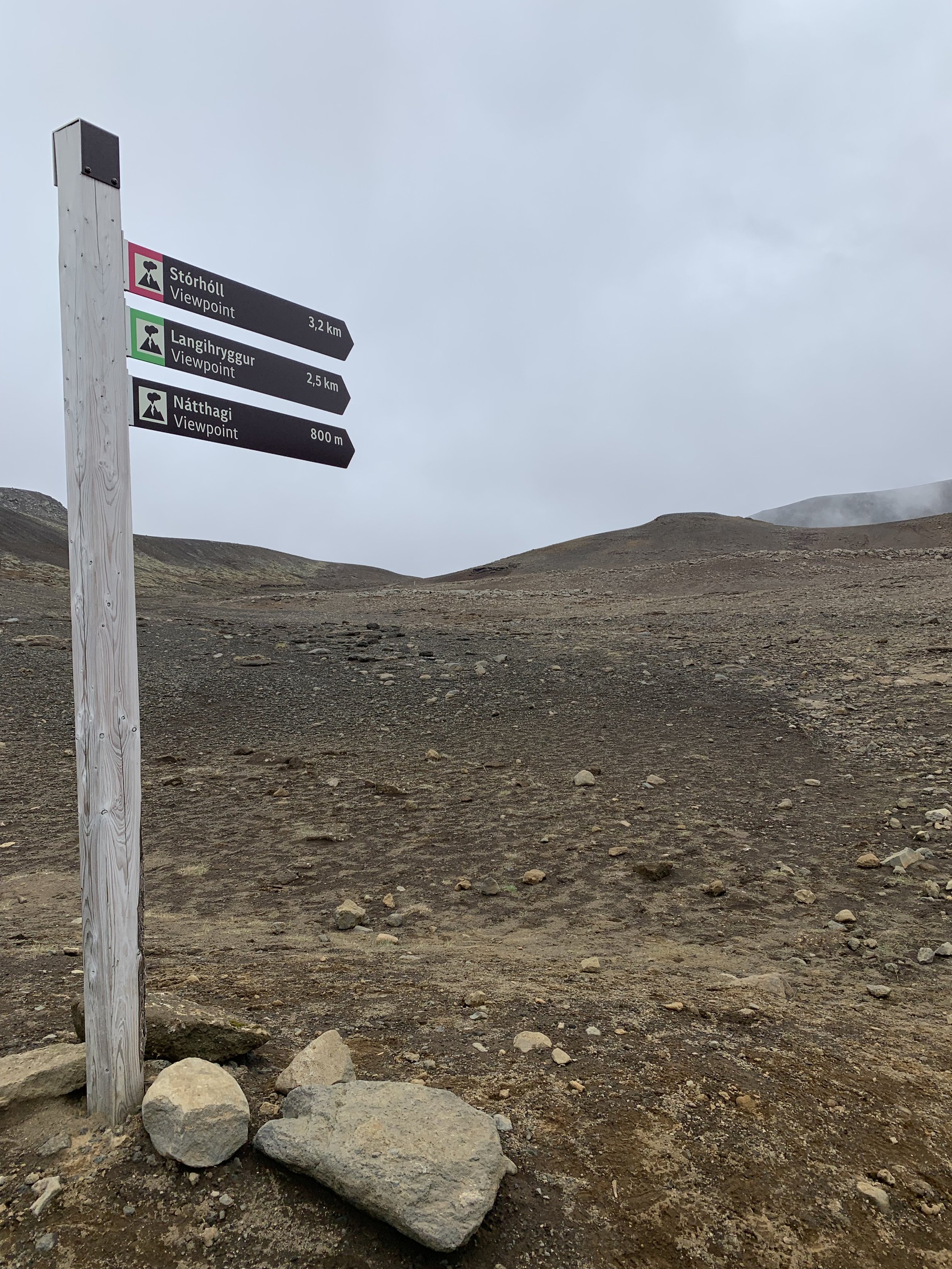

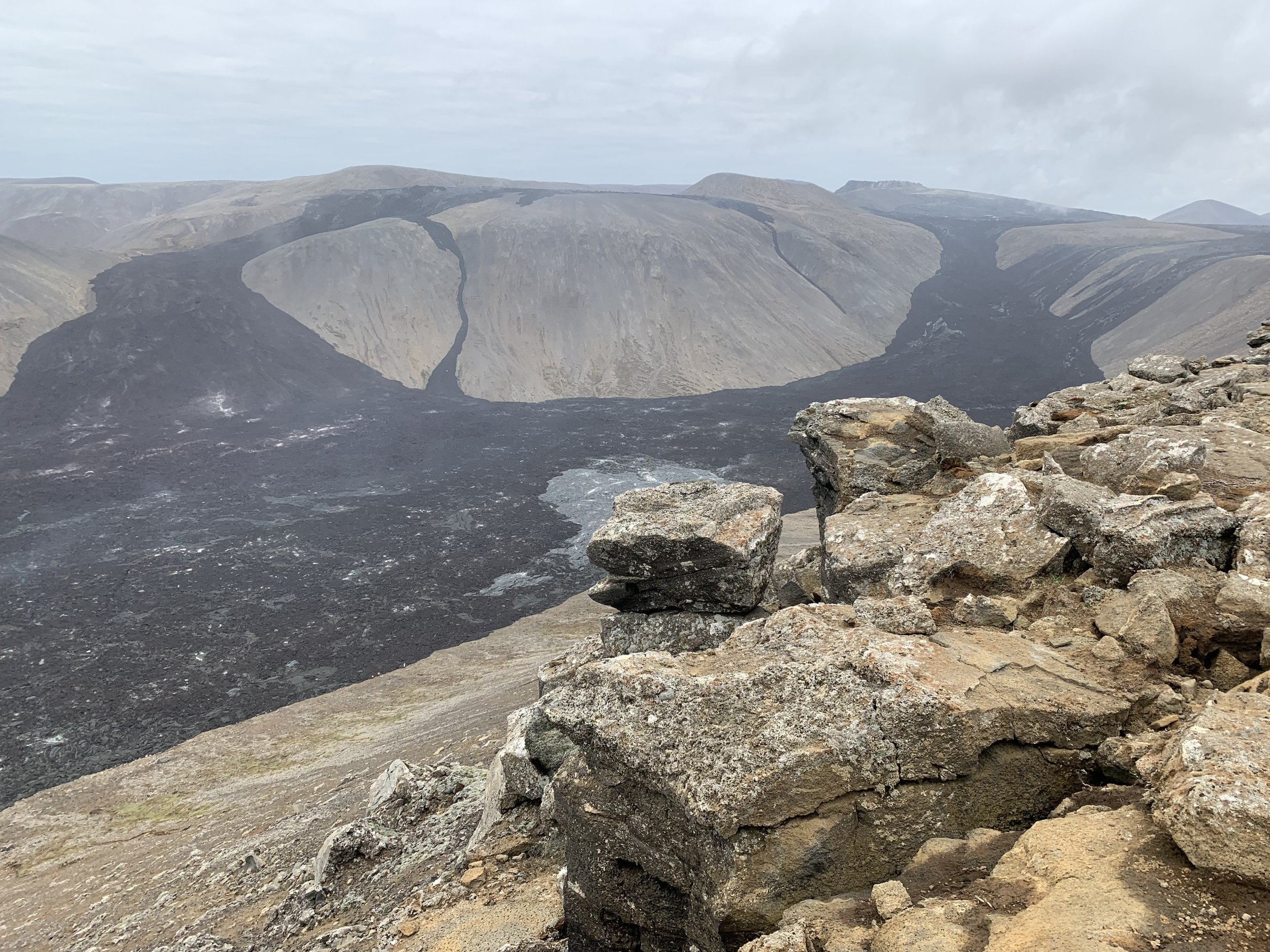


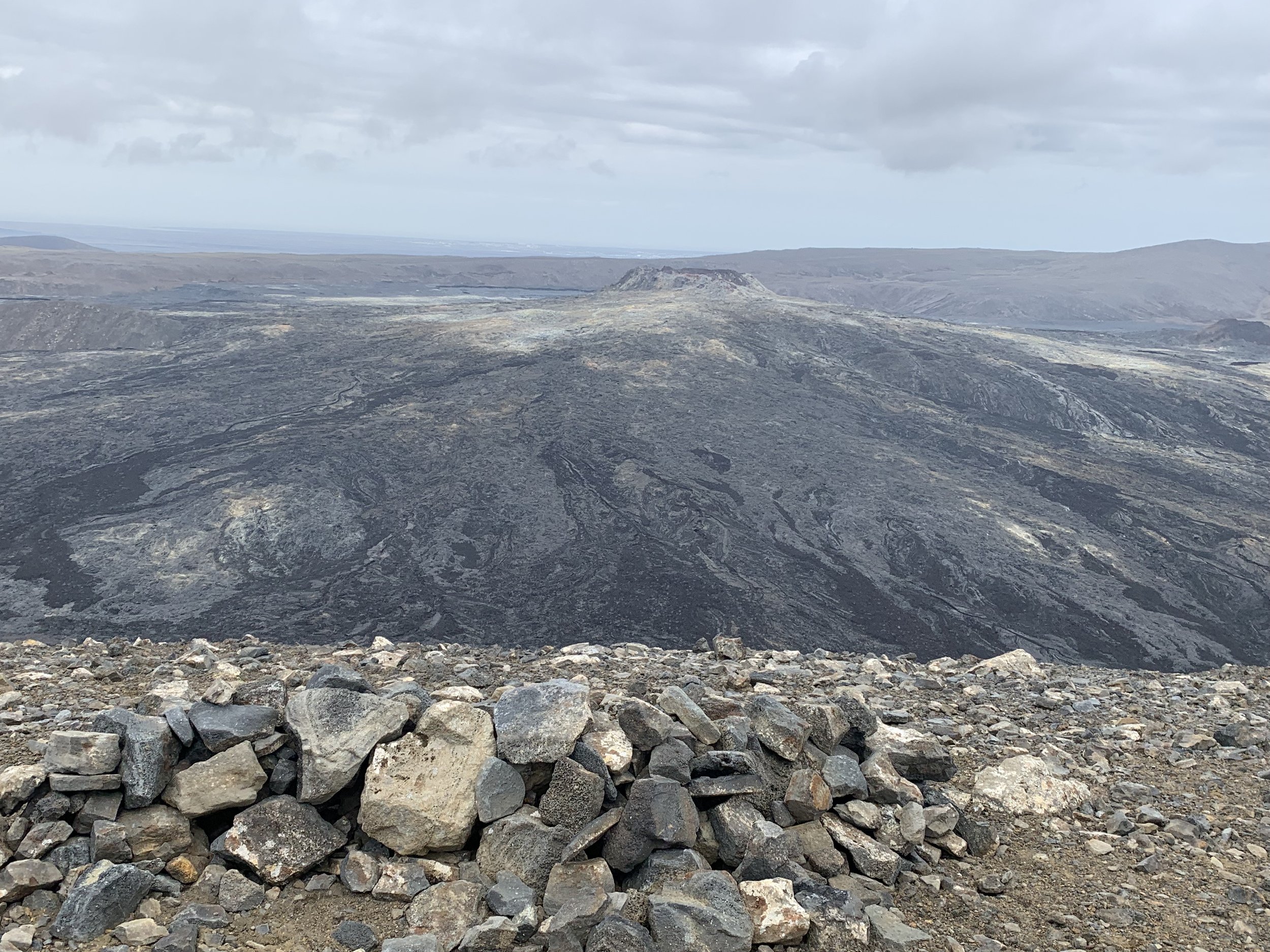
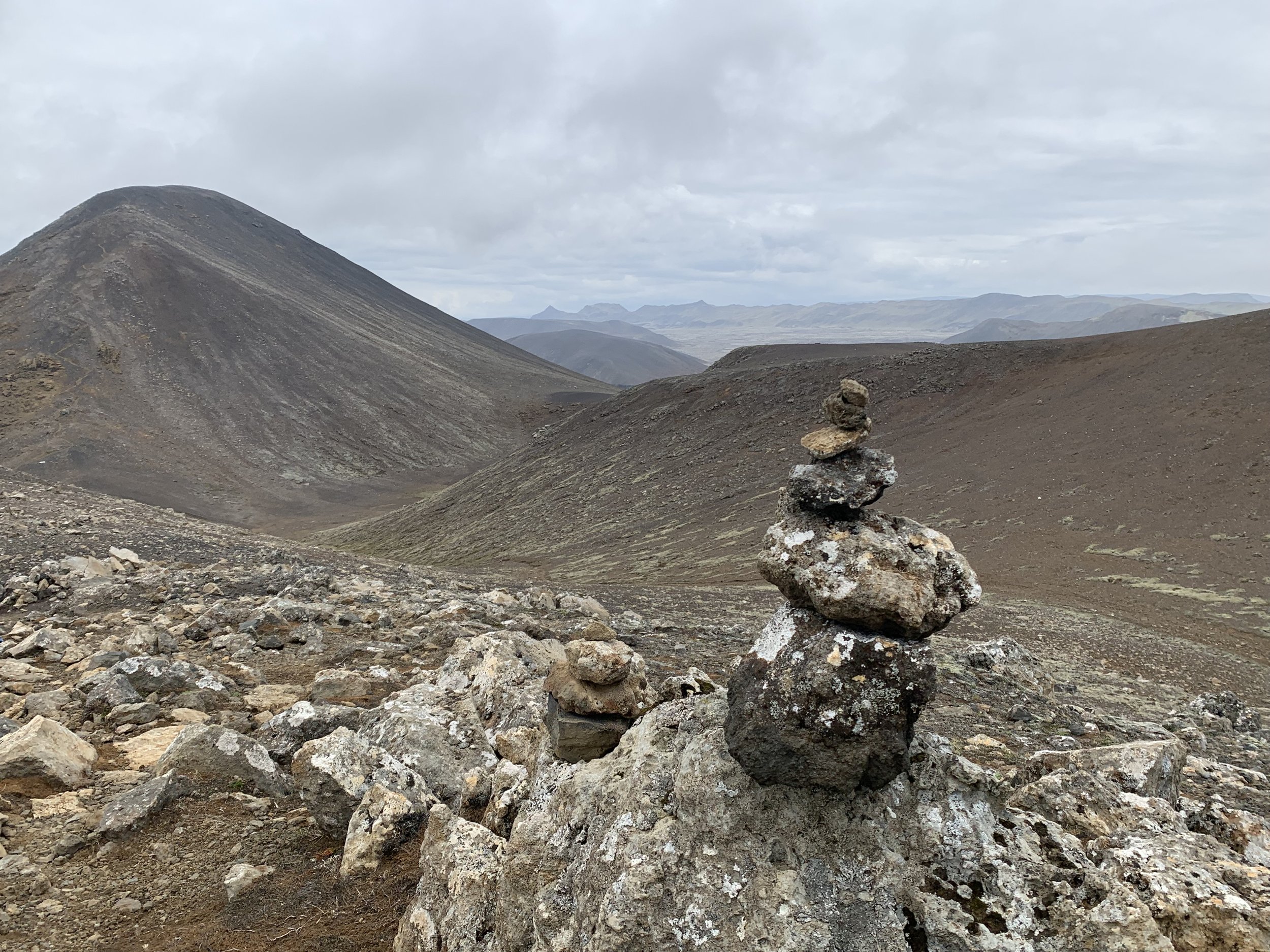
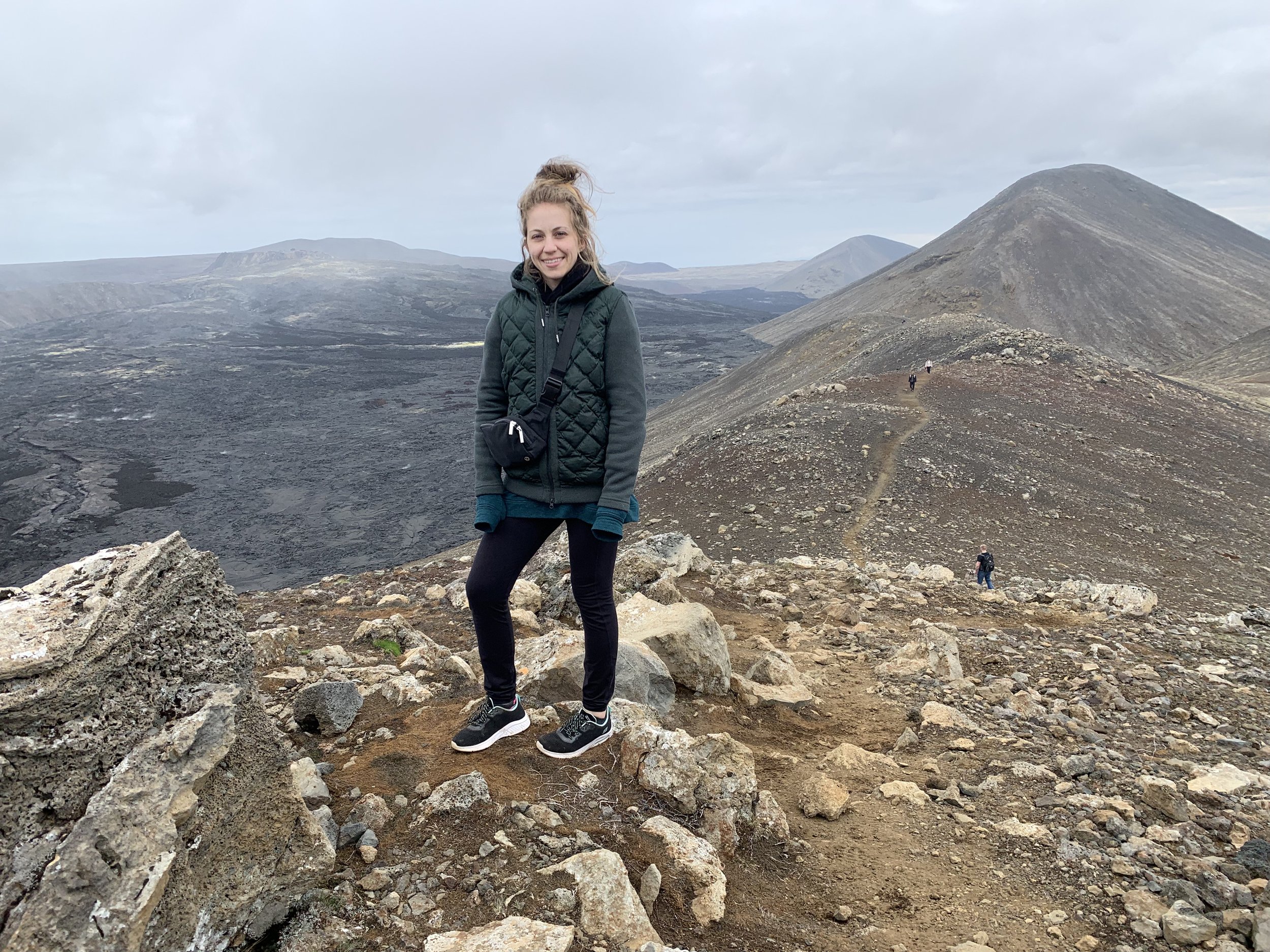
2. Skógafoss Waterfall – If you are planning a trip to Iceland and decide that the camping route is more your style, Skógafoss Camping Ground is a popular spot to set up. It’s located right in front of the well-known Skógafoss Waterfall. There’s actually a 24.3km long pathway behind the waterfall that takes you all along the Skógá river, where over thirty other waterfalls stem from.
Next to Skógafoss, there’s a staircase of over 500 steps that begin the hike along Skógá River, which totals five miles. There is a platform right at the top for a bird’s eye view of the top of the waterfall. If you decide to continue past the platform, the rest of the pathway is made of dirt and rock. We did not hike the entire path, but the part we did hike was fairly easy to do. Keep in mind, there are only a few ropes to block off the edges of the valley; there are no fences or other barriers.
At the base of Skógafoss, be sure to protect any electronic gear. The water is very powerful and in combination with the wind, can spread further than expected. If you don’t mind getting a little wet, or are more prepared, a popular photo op is just to the right of the waterfall. Rainbows are also a common occurrence at this location.
To the right of the staircase, there is a little farm where baby goats and sheep can be seen grazing the fields. There is also a station with showers, bathrooms, and a dishwashing sink if you do camp and have some cleaning to do. There is a fee to stay overnight, but if you stop by just to see the waterfall during the day, parking is free.
Definitely a stop worth making!
3. Strokkur Geyser – This geyser is one of many located in a high geothermal area called Haukadalur Valley. It erupts every five to ten minutes and up to 20 meters high on average. It is the highest erupting geyser in this particular park. This area has several smaller “mud pots” along the pathway towards the giftshop as well.
It is a spectacular phenomenon to witness Strokkur, especially since it cannot be timed specifically. It is good to note the wind direction of the day as well, because you could be in for a splash. The amount of steam that follows the eruption forms an opaque wall of slowly drifting fog. The fog itself is particularly scentful. The rotten-egg smell comes from high level of hydrogen sulfide gas in the geyser basin. It is very potent and lingers throughout the front of the park.
Haukadalur Valley is home to not only geysers and mud pots, but also geothermal mineral springs. These mineral springs vary in their milky blue intensity. The blue is thought to come from silicic acid, sulfur, and the reflection of the sky.
Lastly, there is a hiking path towards several viewing platforms that overlook Haukadalur Valley in its entirety. This view is incredible and allows you to see everything in combination: Strokkur eruptions, the steam coming from the mud pots and smaller geysers, as well as the blue mineral water within a sea of yellow, green, and red rock. These colors come from sulfur, copper, and iron, and make for a beautiful landscape.
The park is public property and is free entry with no parking fee. There is also a giftshop and cafeteria with varying Icelandic and American dishes readily available. On a whole, the park is very well maintained and a true geothermal experience.
4. Gullfoss Waterfall – This waterfall is located relatively near the Strokkur Geyser, also in Haukadalur Valley. It is off the trail of Sigridur. There are actually two separate falls running off the same river, and walking paths that run along the left side. You can’t get quite as close to the falls as Skógafoss, but Gulfoss is just as impressive. The first path leads to a viewing platform looking down on both falls. The second pathway is a little rockier, but gets you up close to the waterfall to enjoy the sights and sounds of the rushing glacial water. It does get quite misty, so be sure to protect any gear you may have. The last path you can choose to venture, is located above both of them.
Going to Gulfoss Waterfall in my opinion, is not an all-day venture. We might’ve been there for an hour perusing the pathways and taking photos, but that was it. It is a great place to stop if you are driving between Vik and Reykjavik though!
There is no parking or entrance fee, which is wonderful! There’s also a nice gift shop and café at this site, where you can enjoy delicious pastries. Overall, a great stop with awesome views.
5. Reynisfjara Black Sand Beach – Black sand beaches are a popular occurrence in Iceland due to the number of volcanos. Reynisfjara is actually the most famous black sand beach in Iceland and is also known for its basalt column formations. The black sand comes from cooled lava rock that has been broken down into smaller pieces. It is a similar texture to the sand that we are familiar with; maybe slightly grittier. The teal waves with their white foaming peaks are a wonderful backdrop for the dark beach. Although beautiful, the waves can be very dangerous and there are warning signs to steer clear of the potential riptides that can pull you under.
If you are not able to make it to Stuðlagil canyon, Reynisfjara beach has its own basalt stacks to see. The columns are a result of cooling magma and the cracks that form as the temperature decreases. They vary in size, shape, and direction as well. The larger columns were very vertical, while the smaller pieces jut out at irregular angles. It’s interesting to know the impact that all of Iceland’s volcanos have had on the landscape.
Being that this is such a popular tourist spot, you may have to park just outside of the lot. Other than that, we didn’t run into any issues and were fully able to enjoy the beach peacefully.
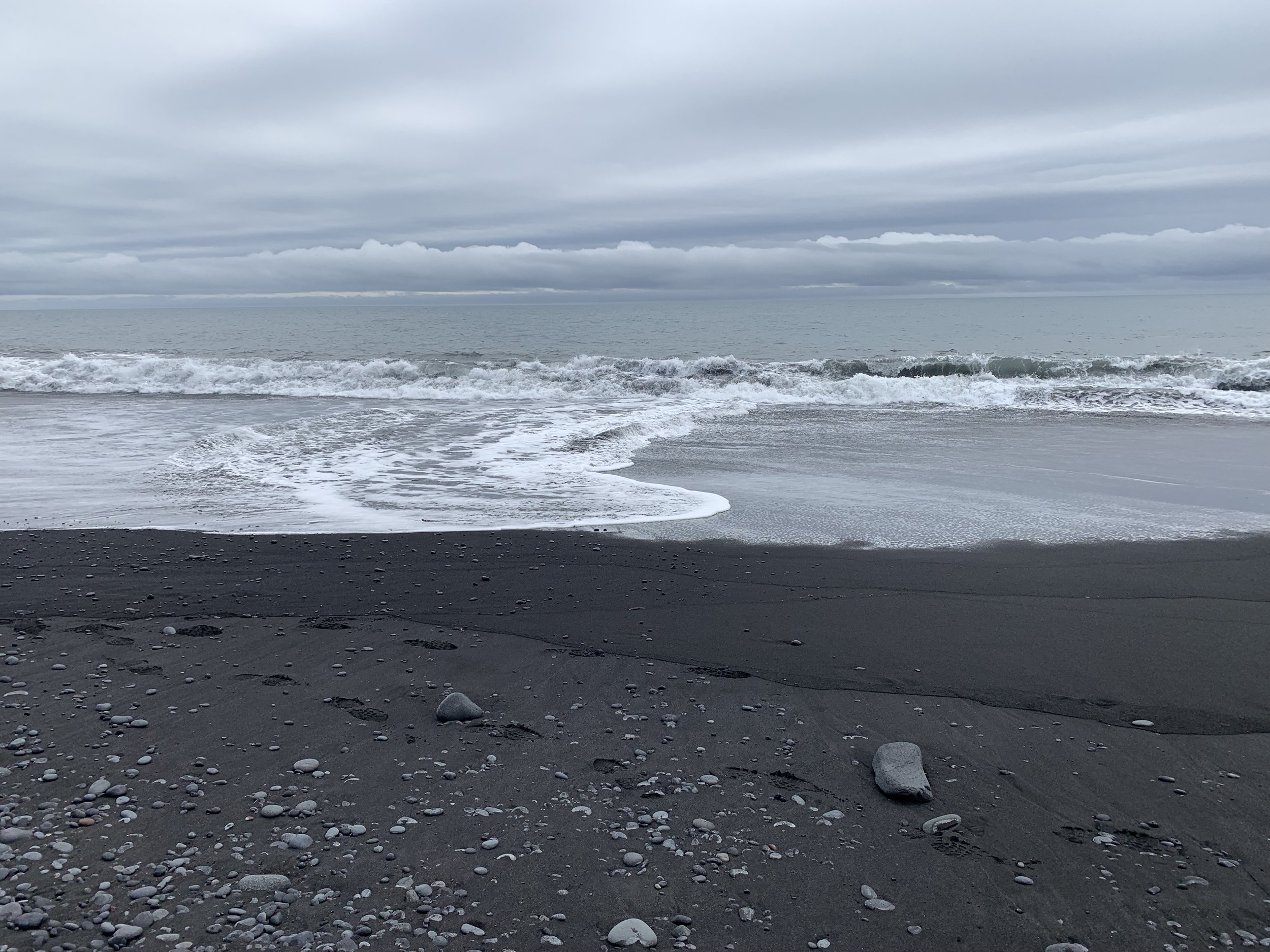
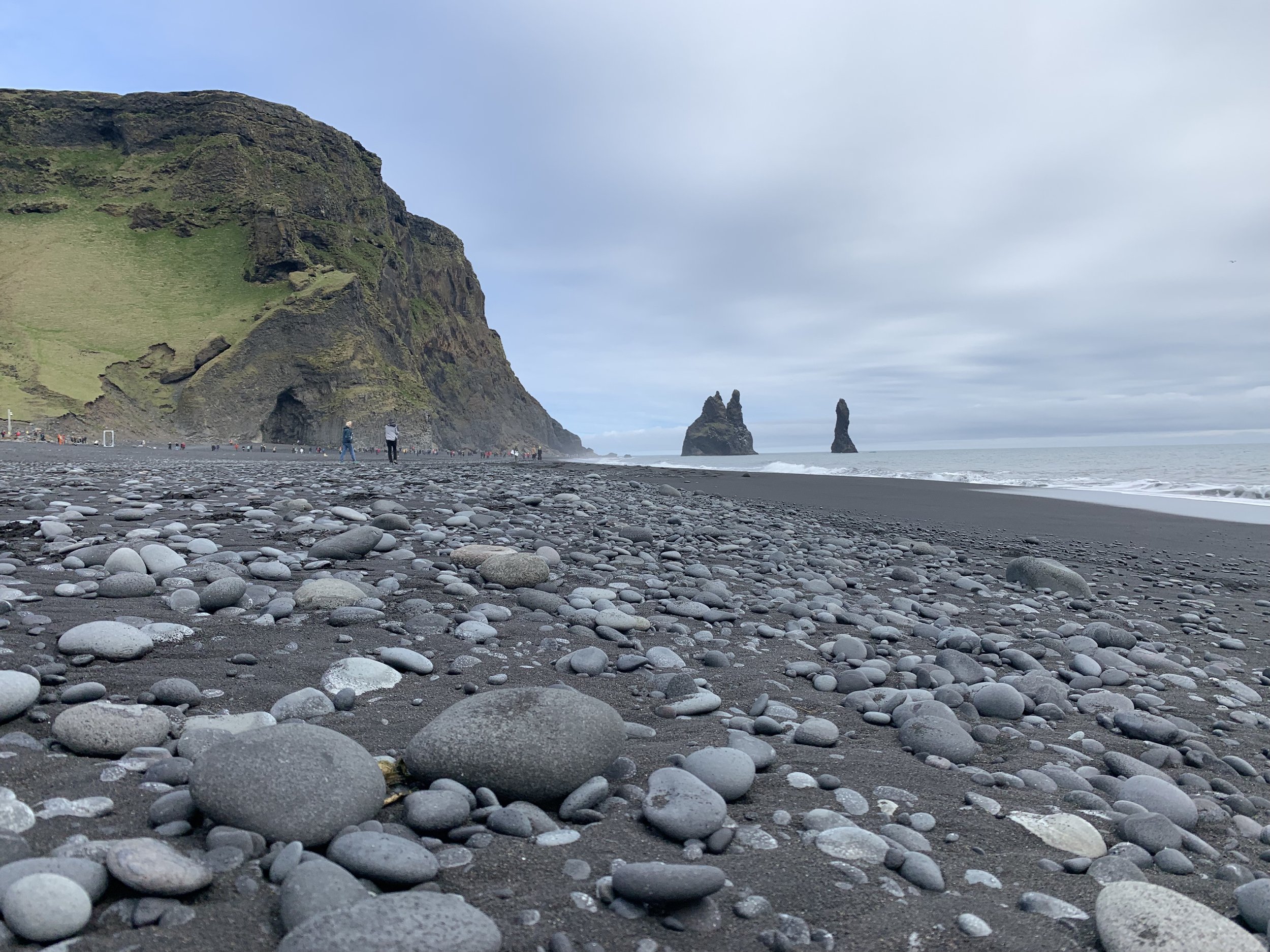
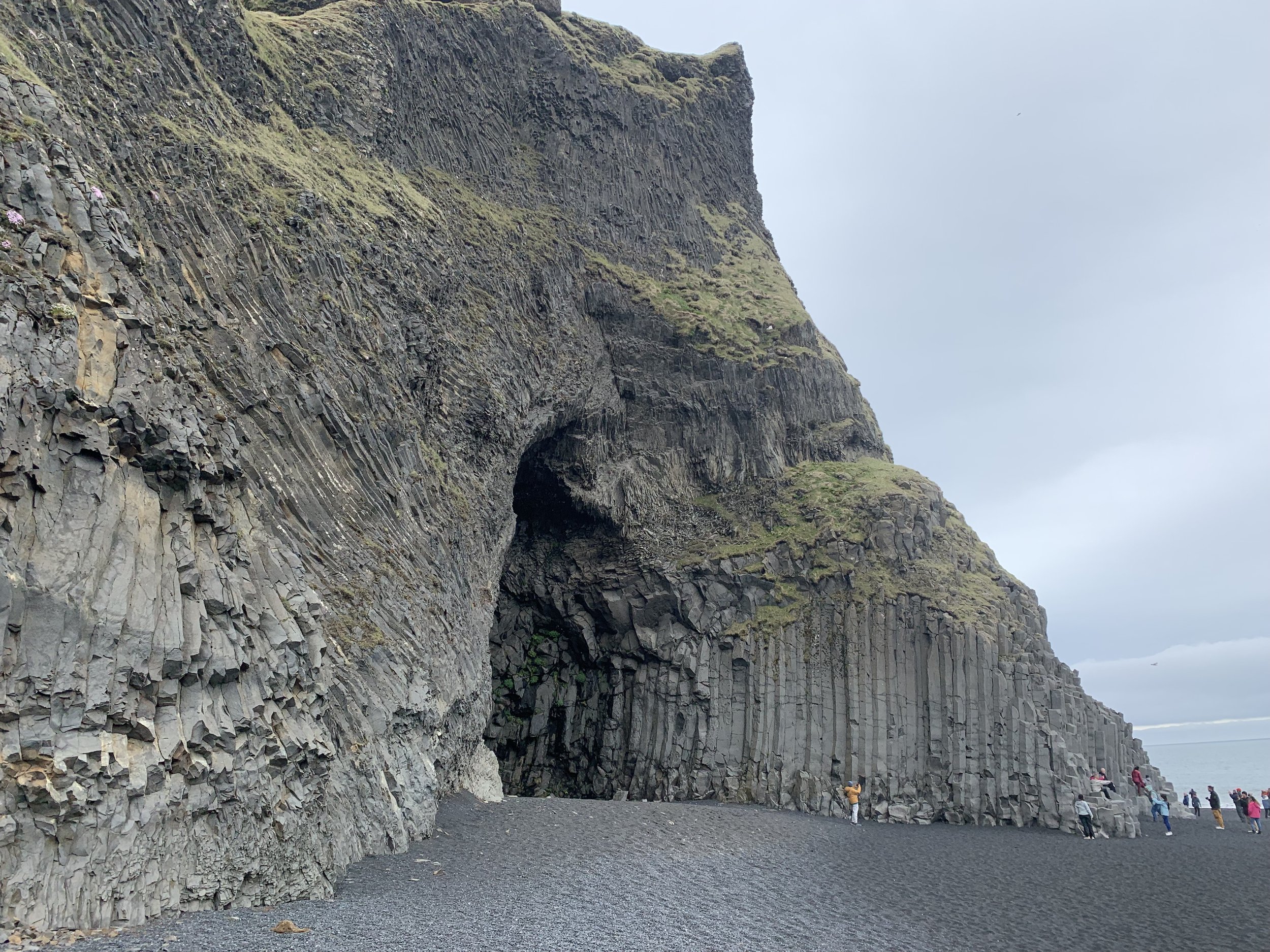
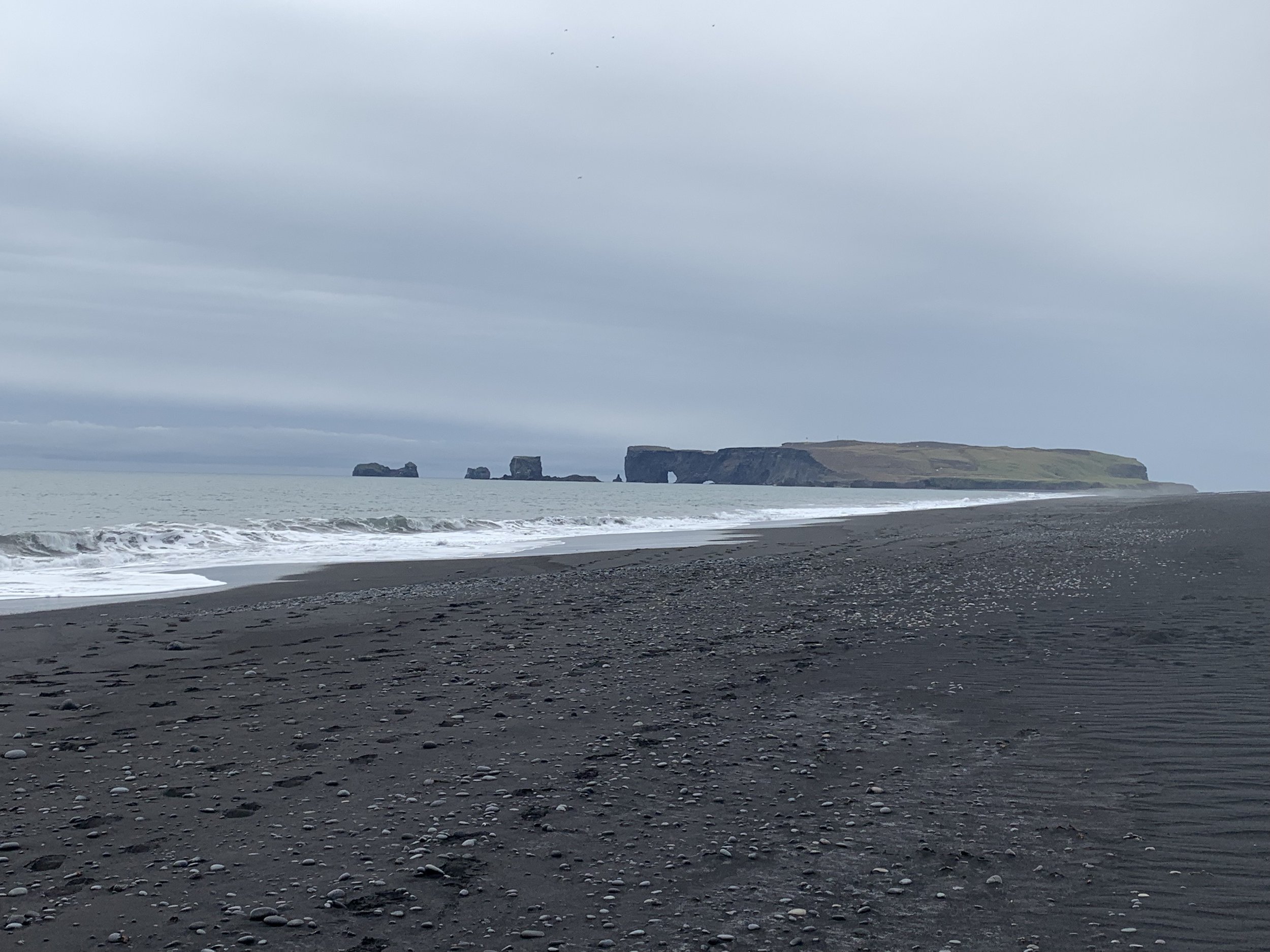
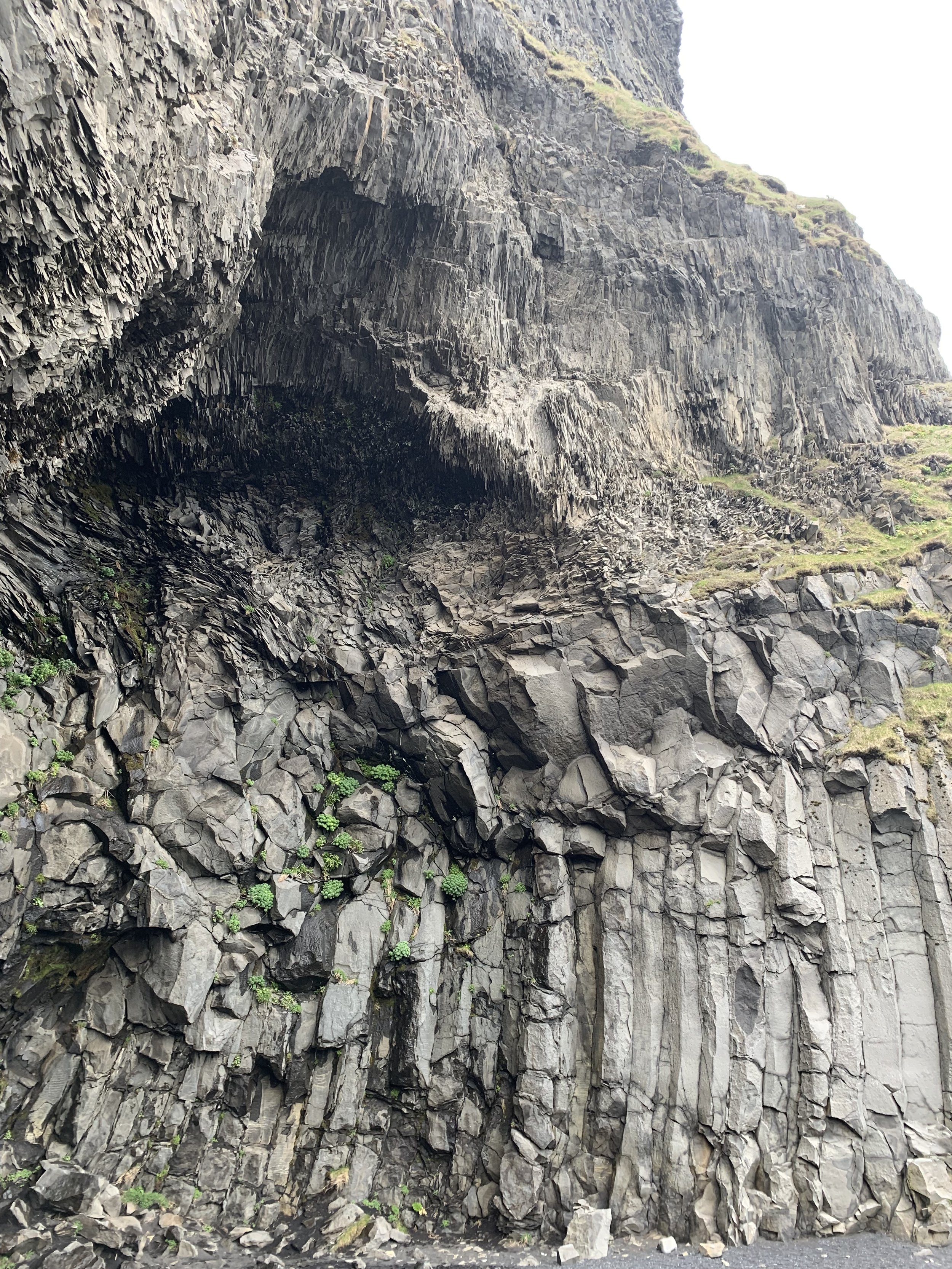
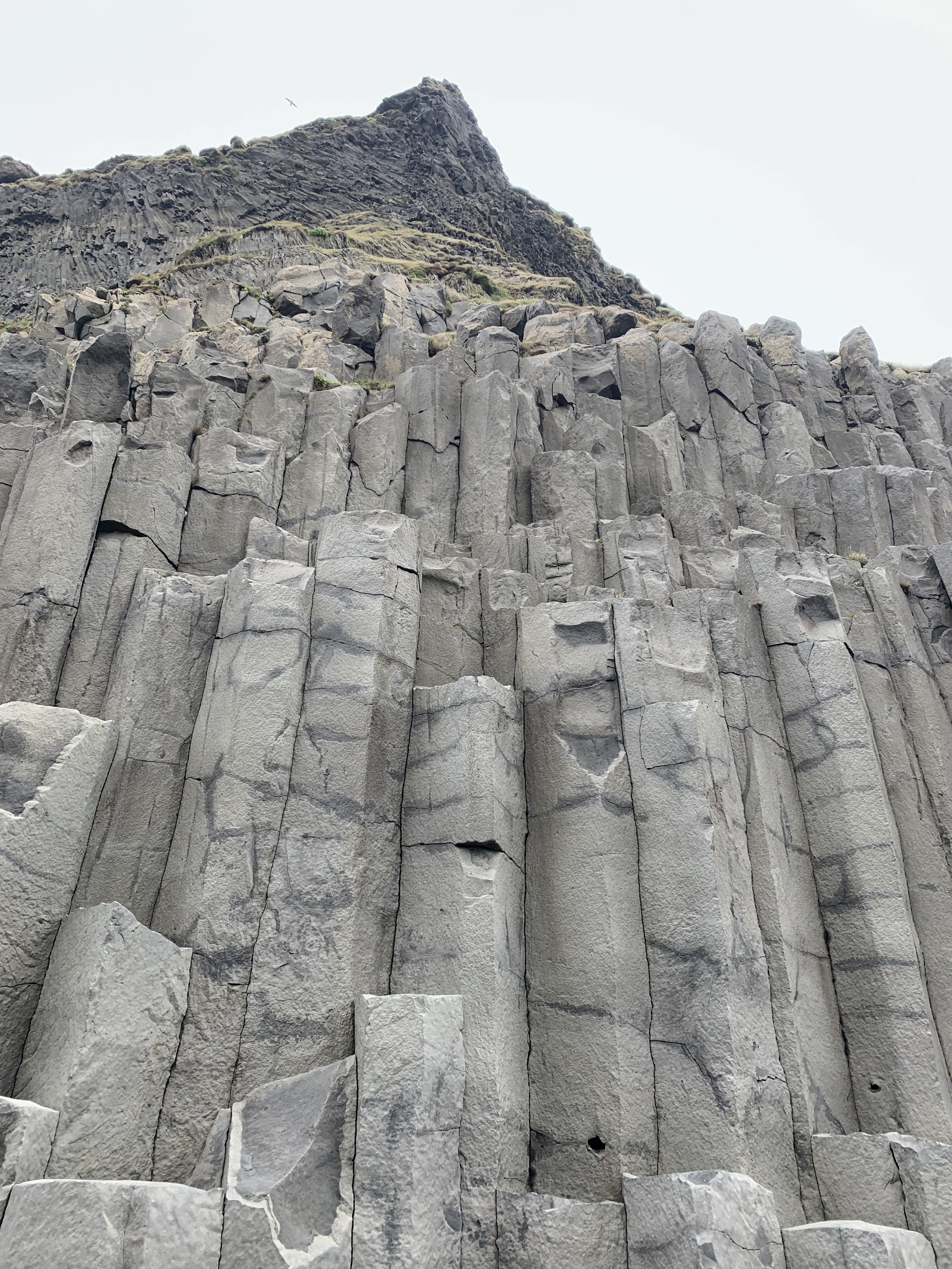
6. Whales of Iceland- The museum is relatively small to what we’re used to in the United States, but just as informative. What sold me were the 23 life-size models of whales that live in the Icelandic waters. These models are hanging from the ceiling and overlapping throughout the museum. Each one has an electronic pad nearby where you can hear and read all about the whales, their size, weight, and other fun facts like what they eat.
If you are into anatomy, there is a station with three interactive screens where you can learn about whales’ senses, organs, and other anatomical parts and how they function.
Towards the back of the museum there is a small movie theater where you can catch a short film documenting a few scientists and their joint experience with whales up-close.
My favorite thing about the museum, is that they encourage and advocate to stop whaling. Whaling is very common in Iceland and a part of the diet as well. On the walls there are QR codes to scan and sign the petition to help raise awareness and to stop the killing of Icelandic whales.
The Whales of Iceland Museum is an informative experience with a great cause behind it.
I was pleasantly surprised by all of the natural attractions and tours Iceland has to offer. The landscape itself is mesmerizing, especially in the summer months where the green mosses are abundant. There is no shortage of sites to see, and hikes to take part in. If you are a lover of nature and being in the great outdoors, visiting Iceland is a must!
